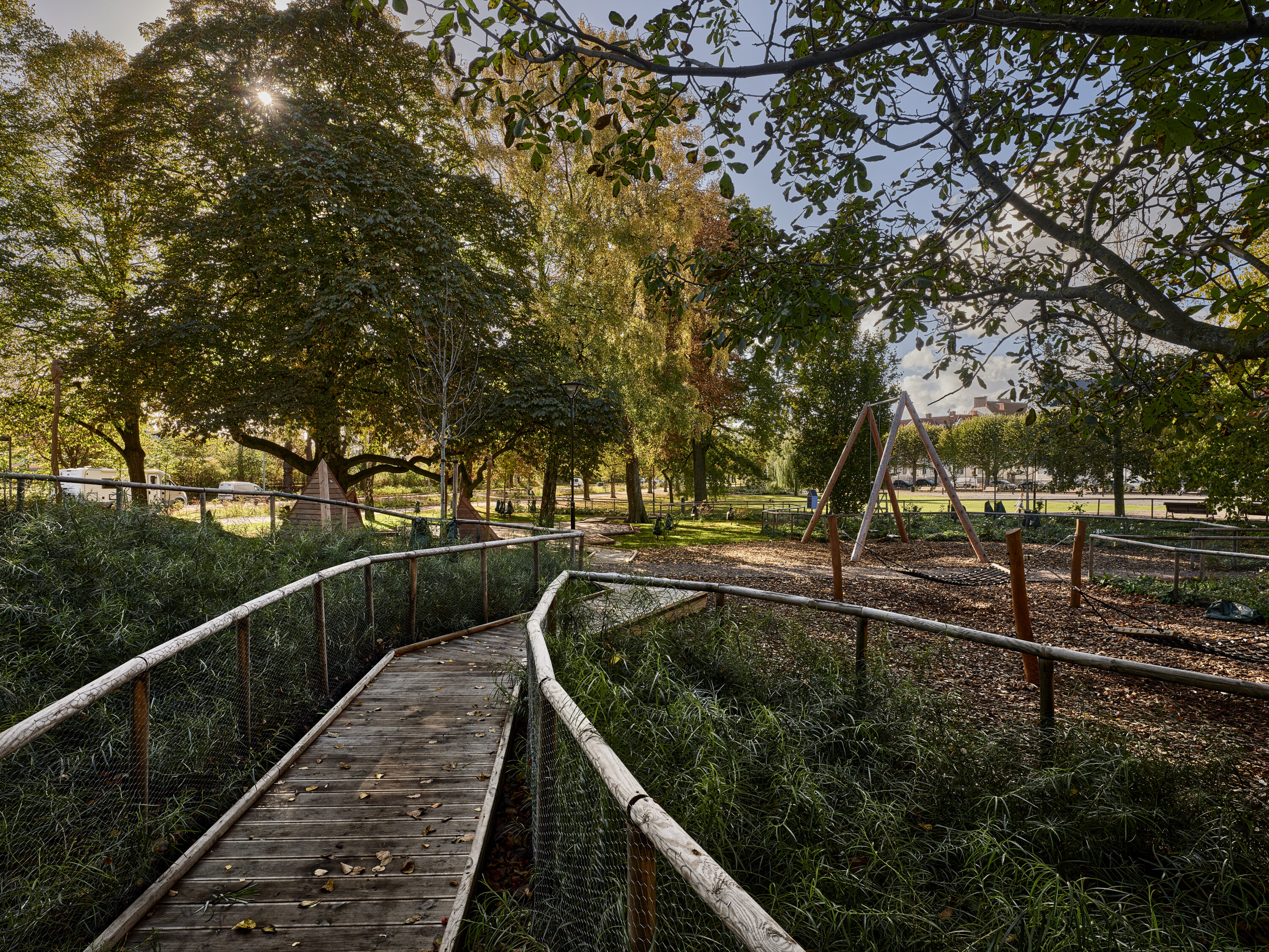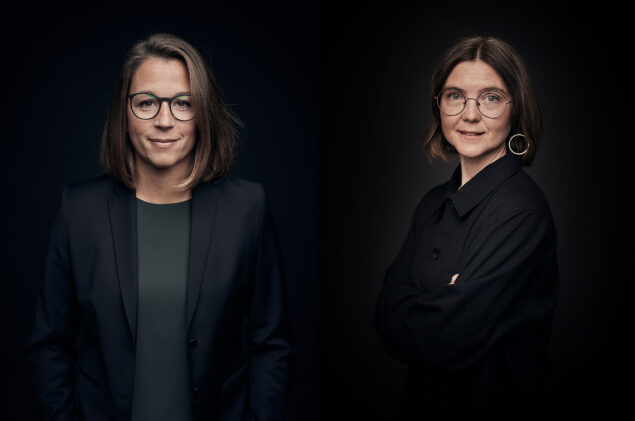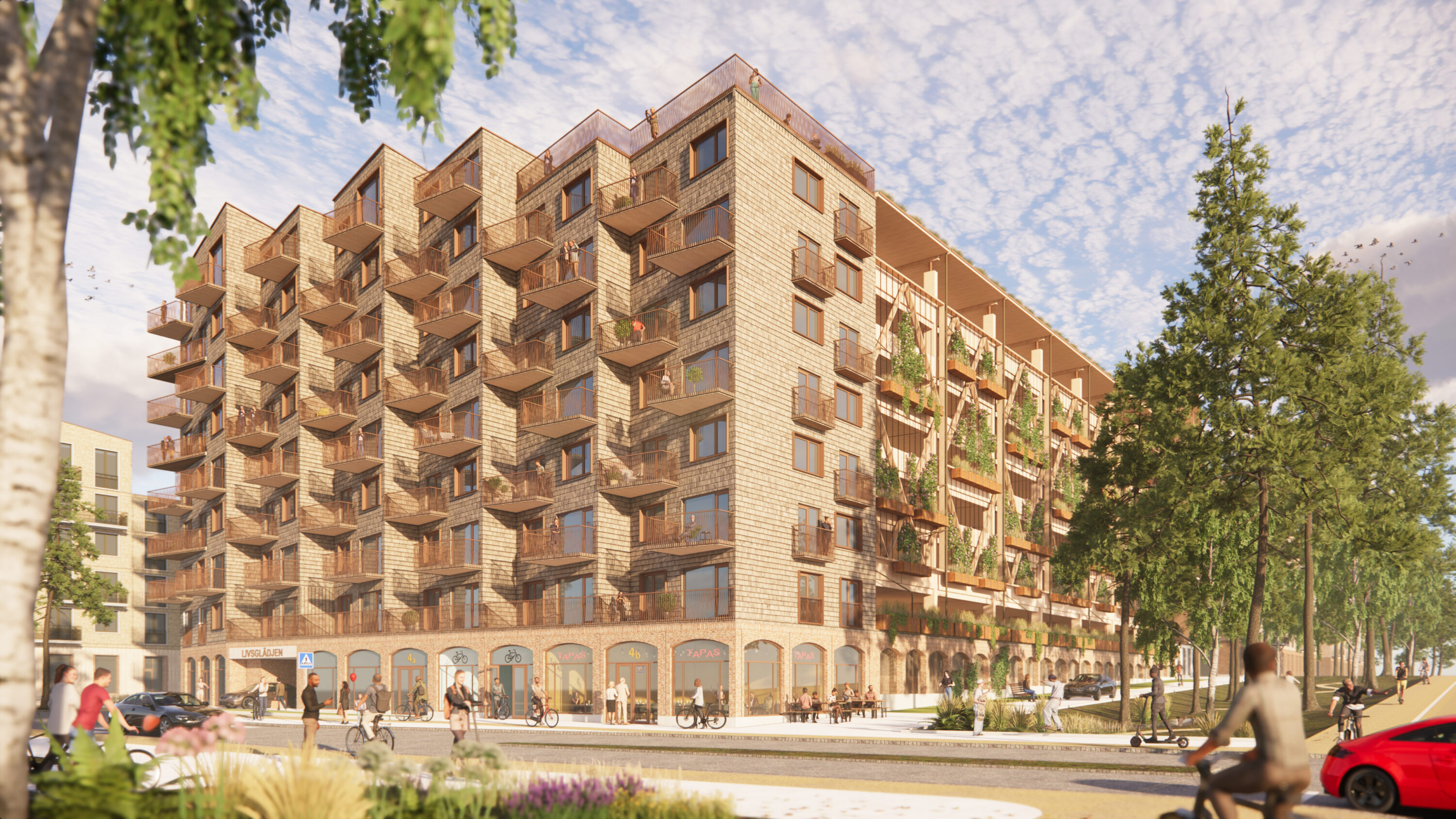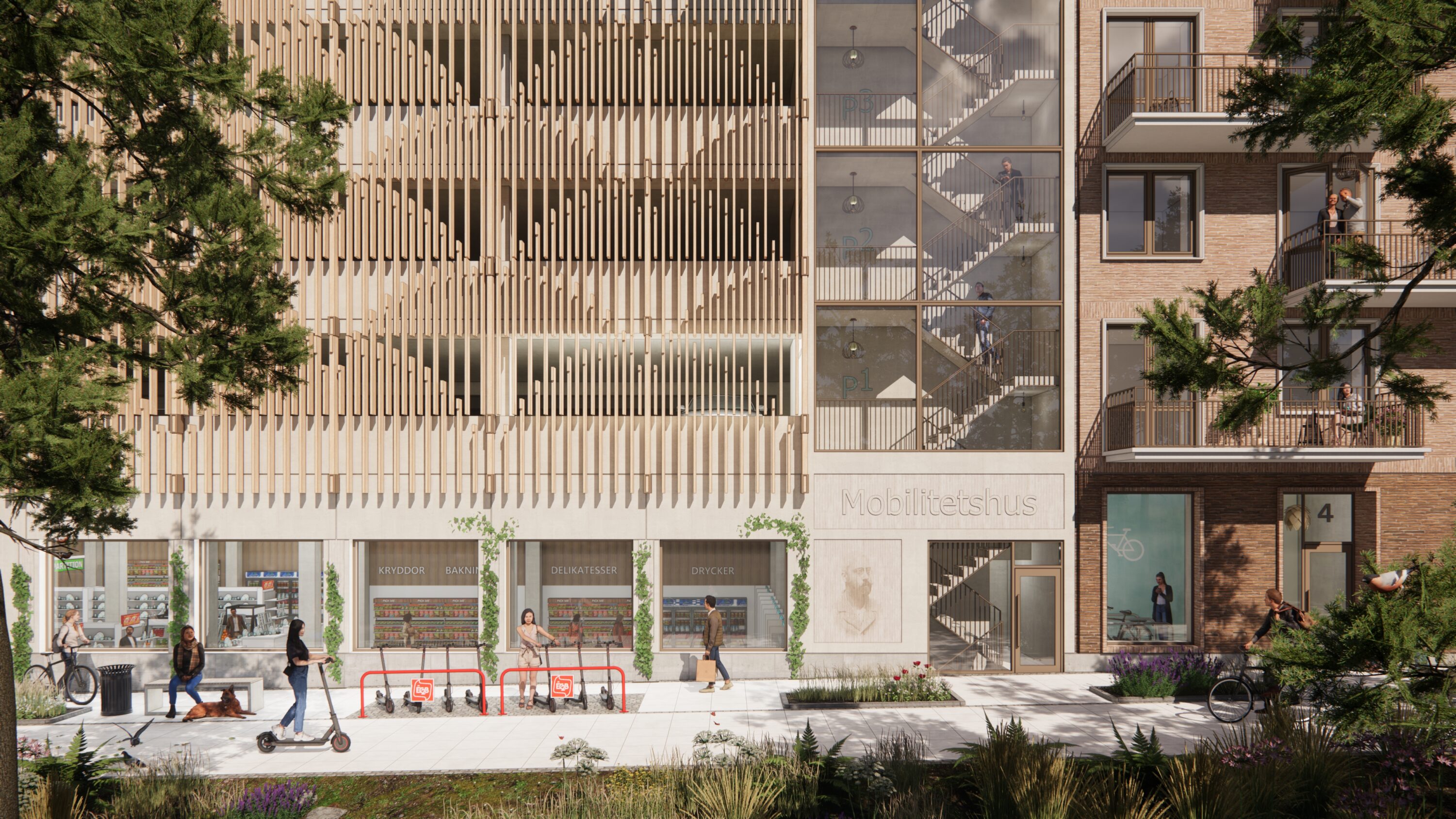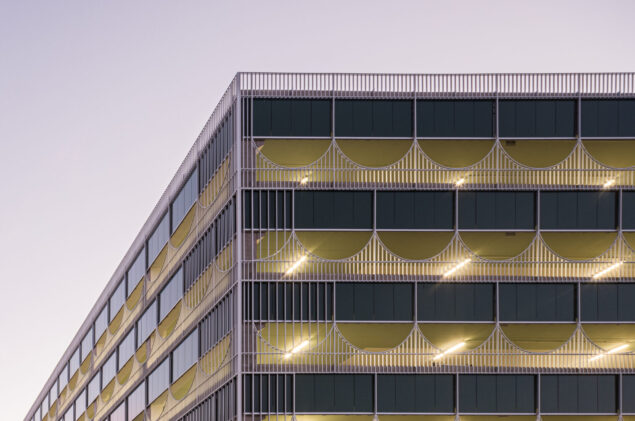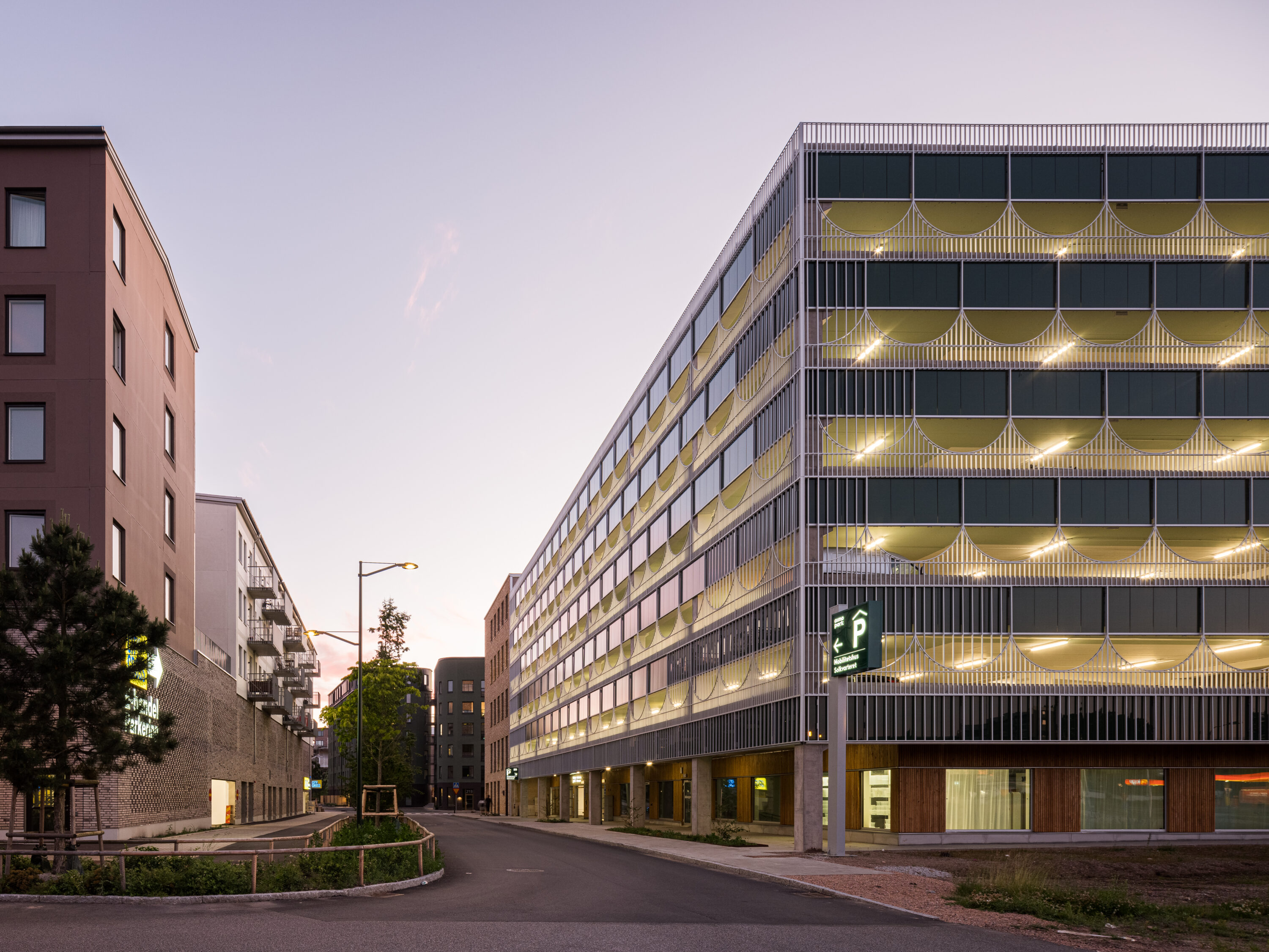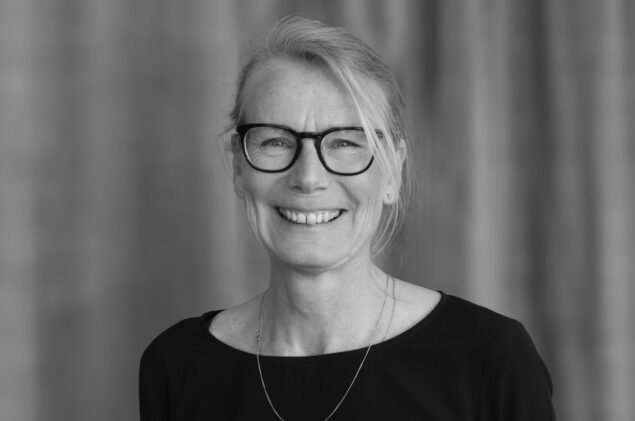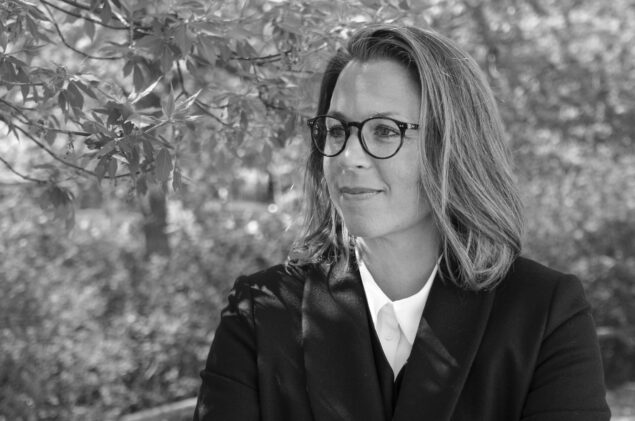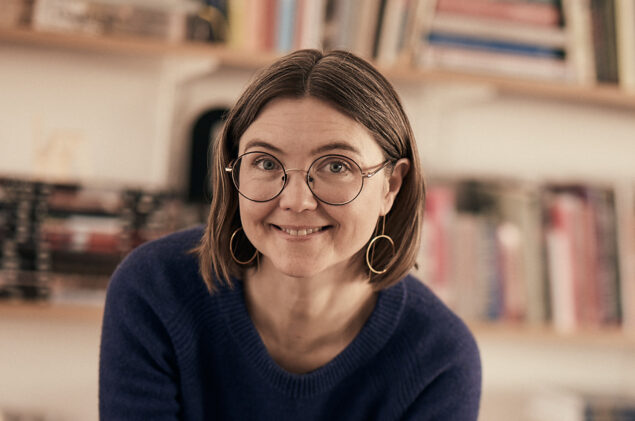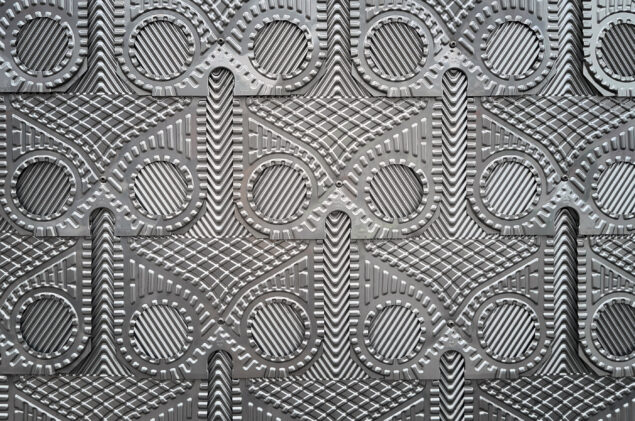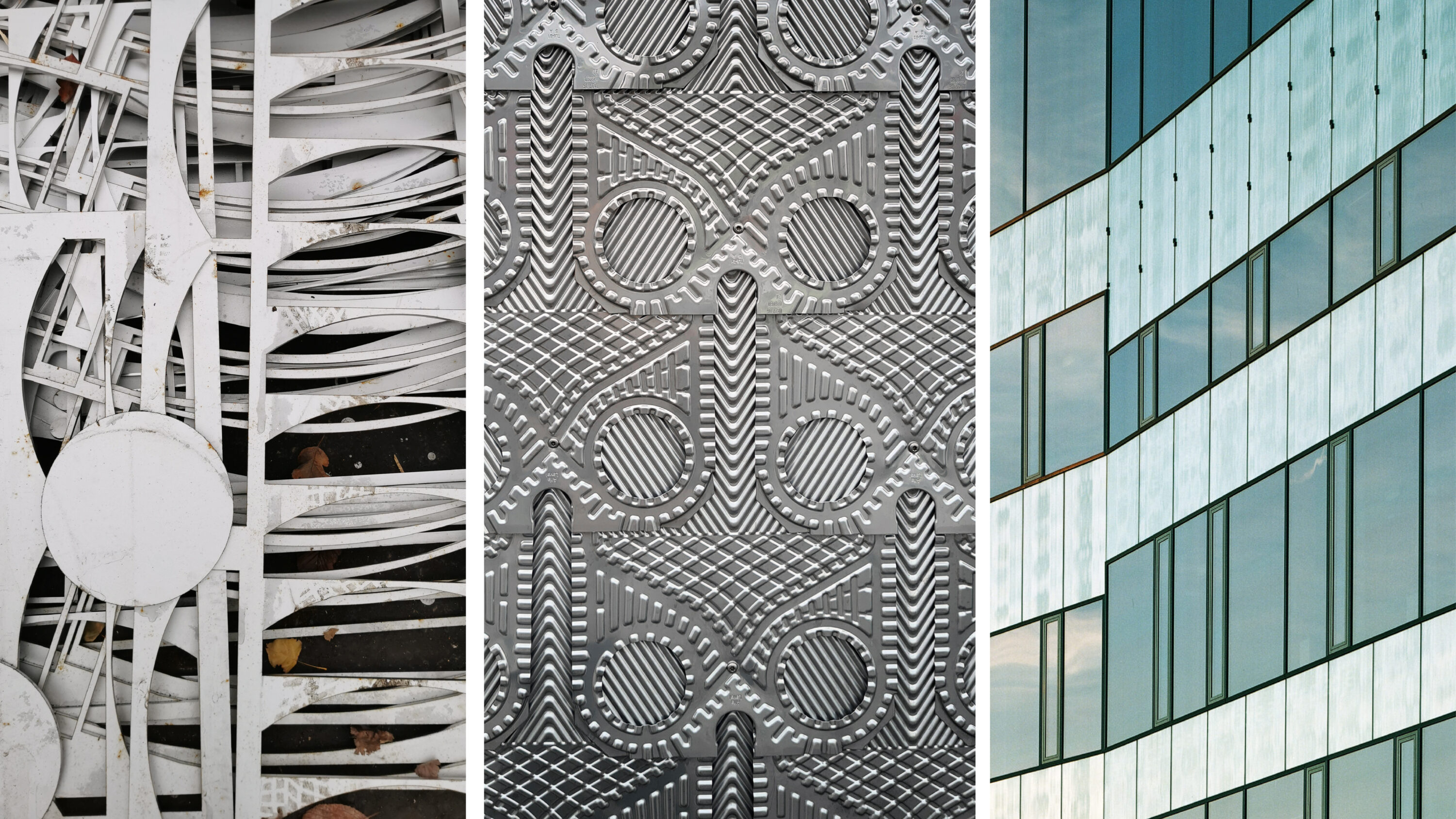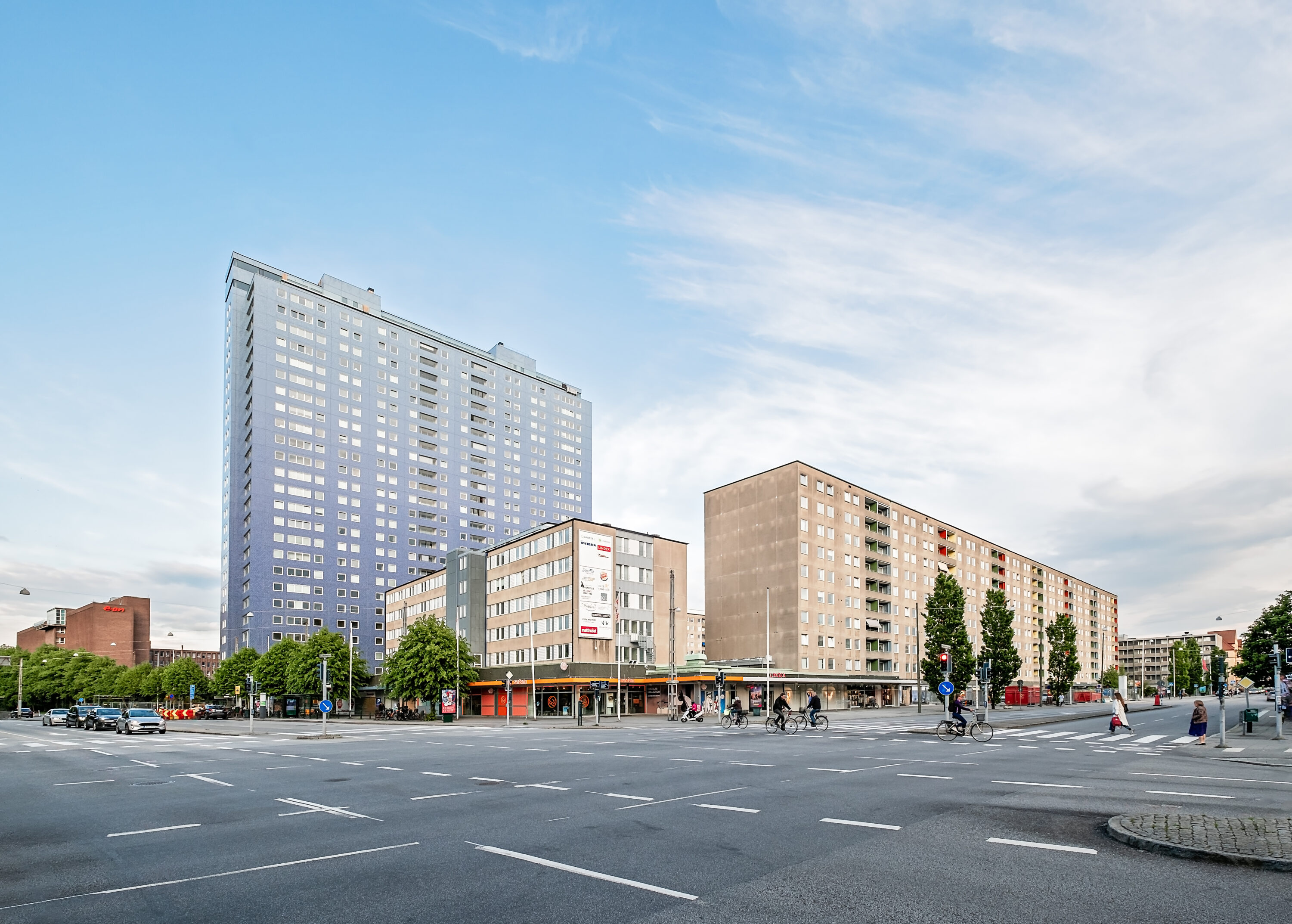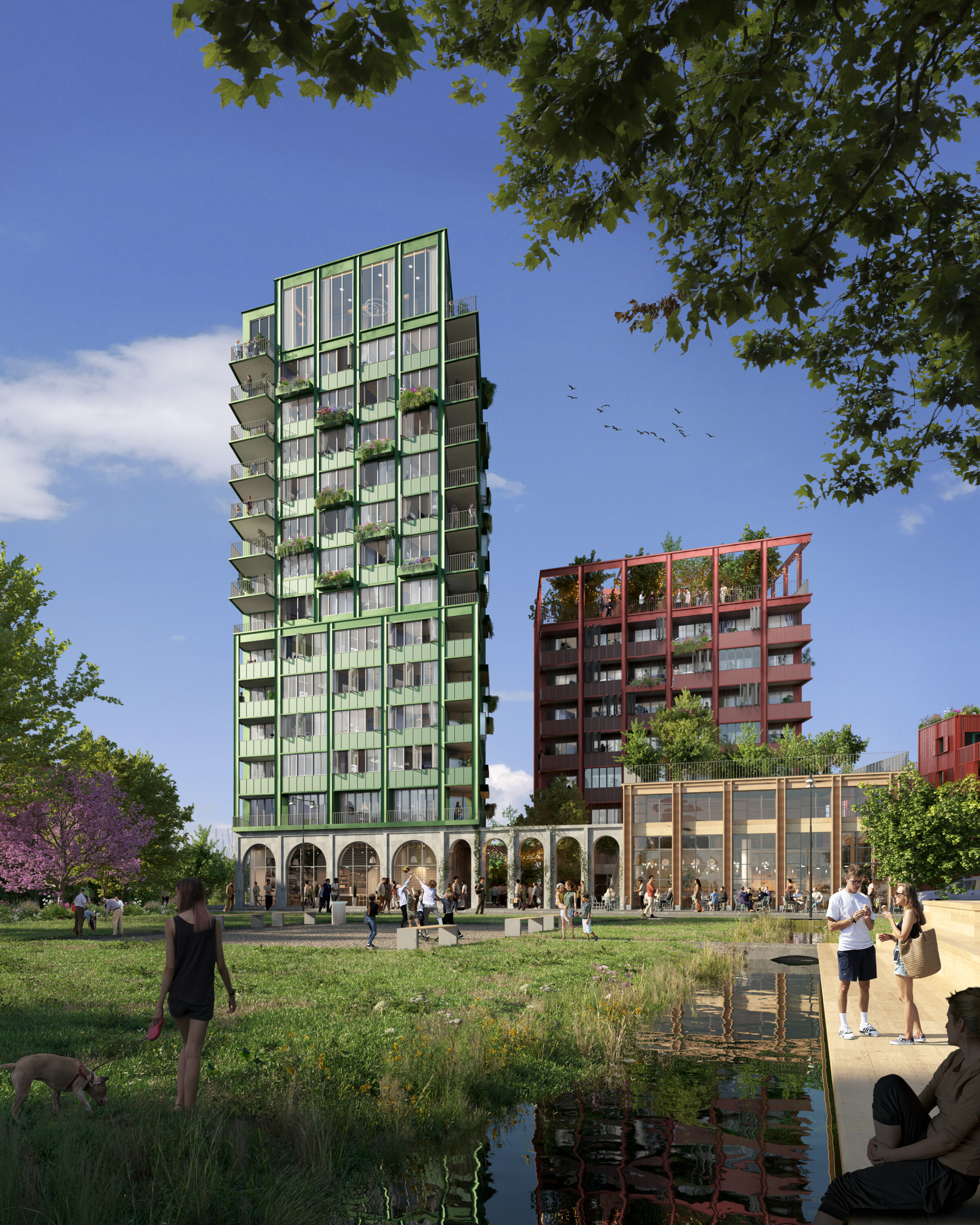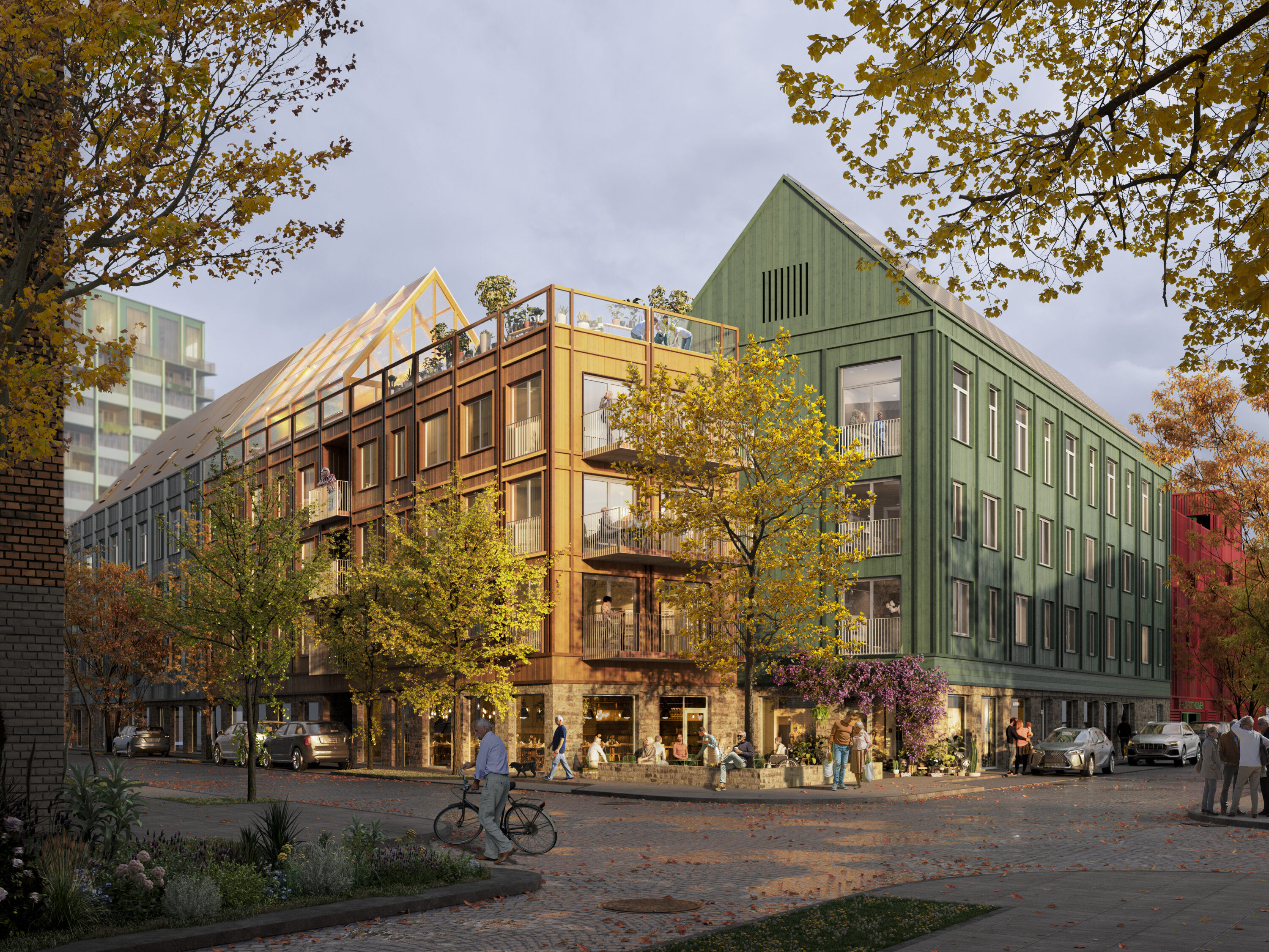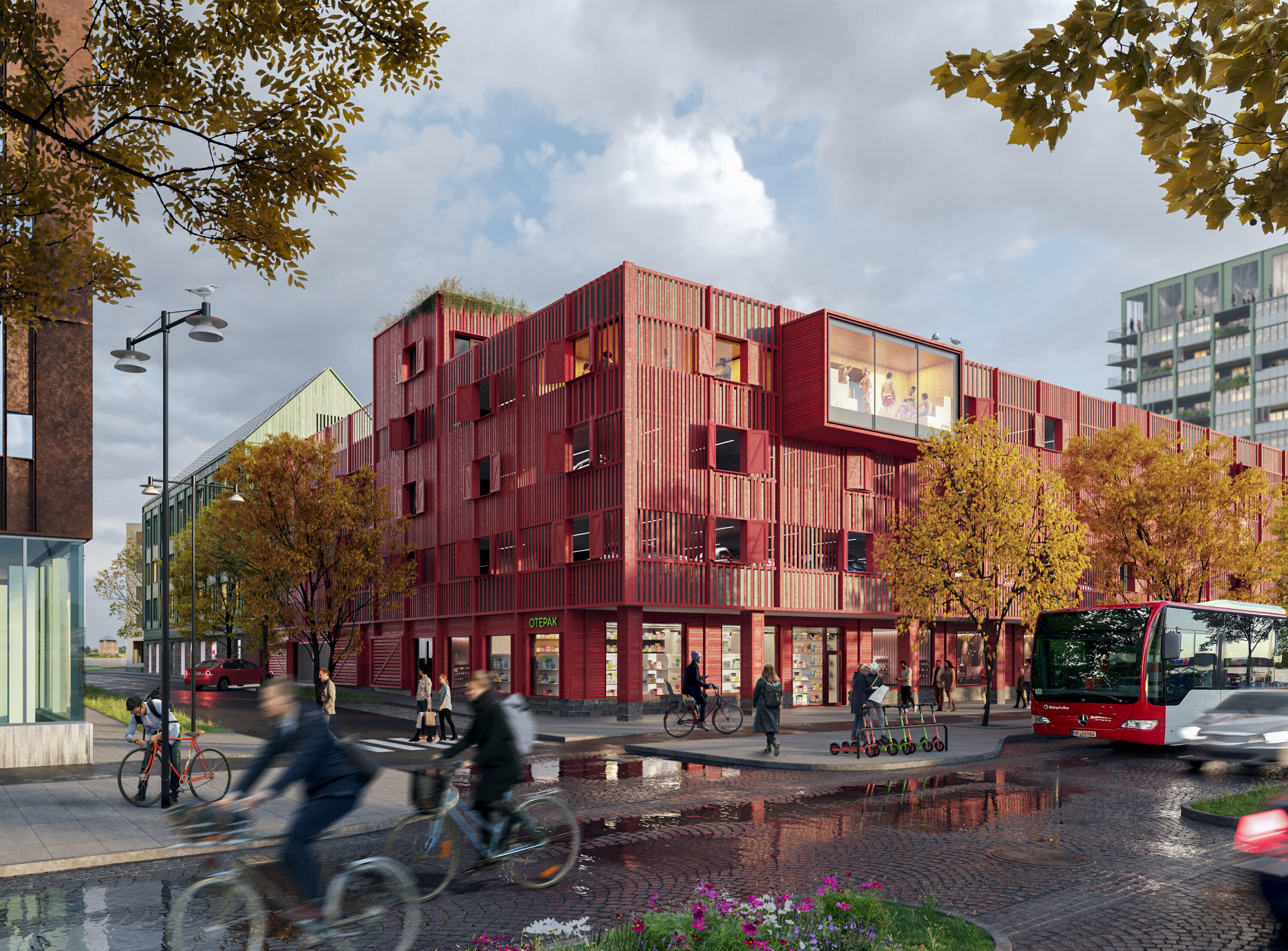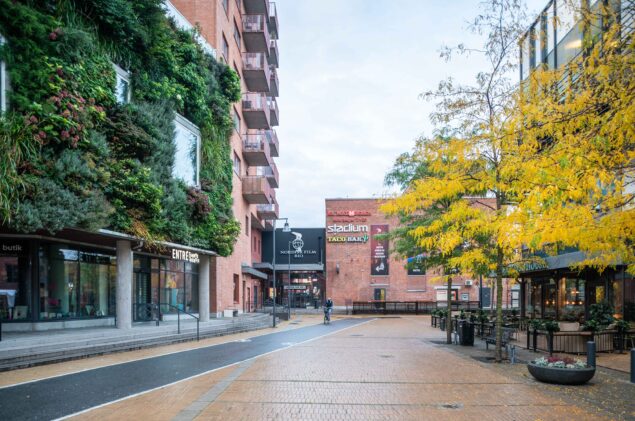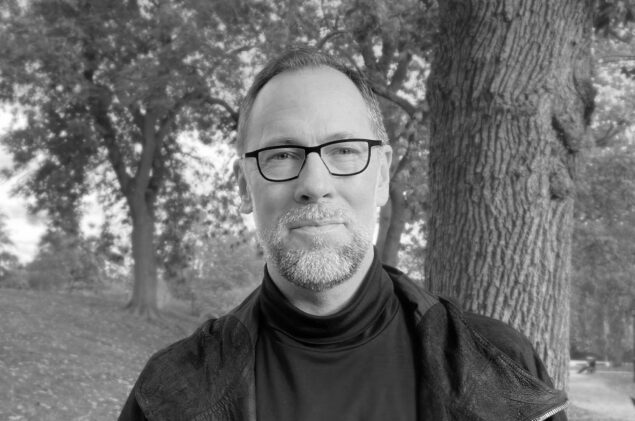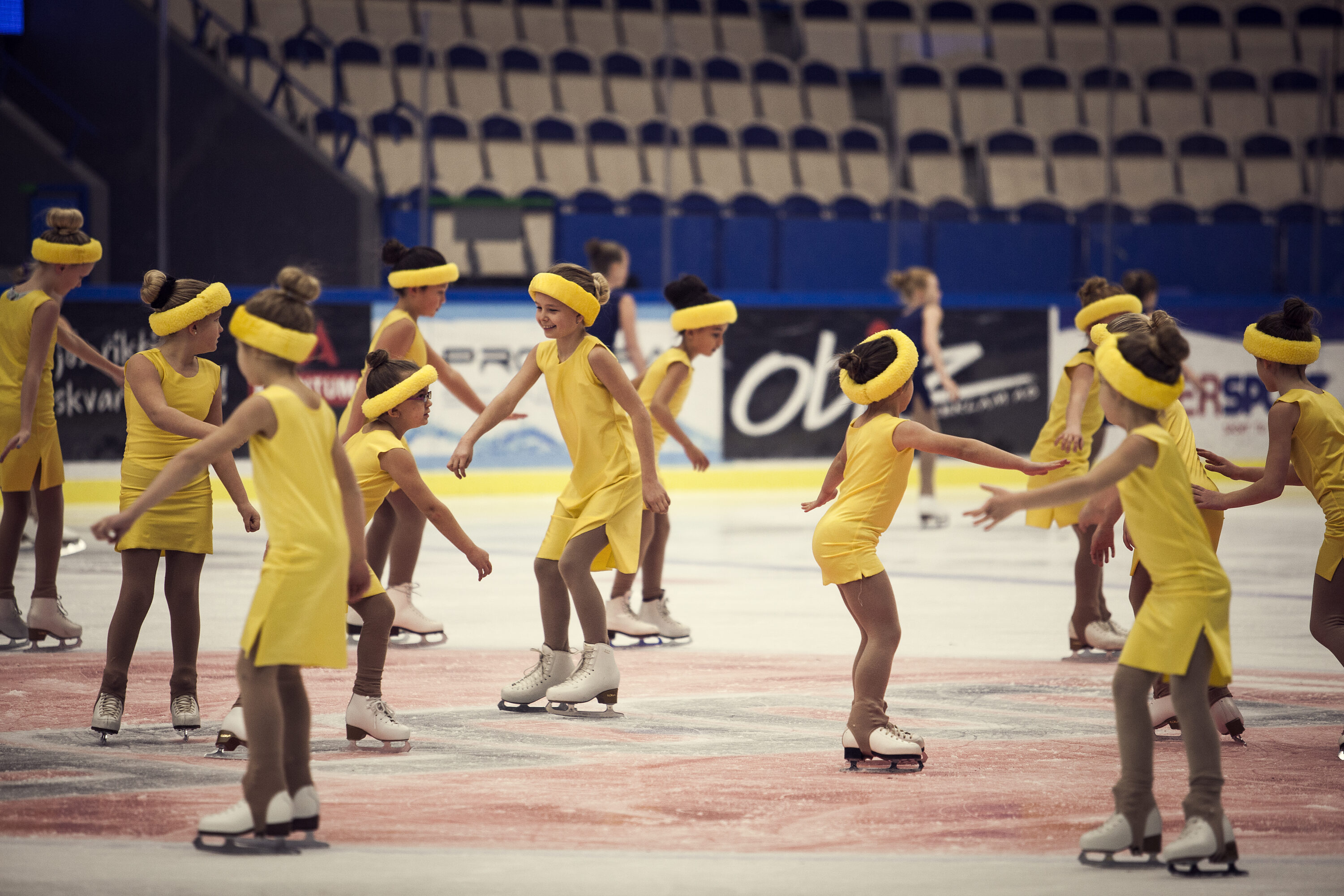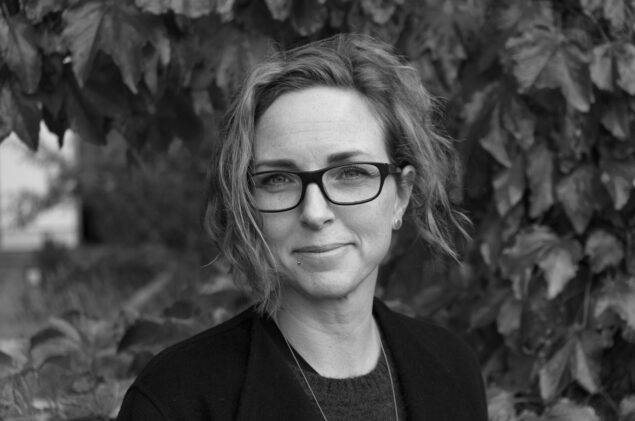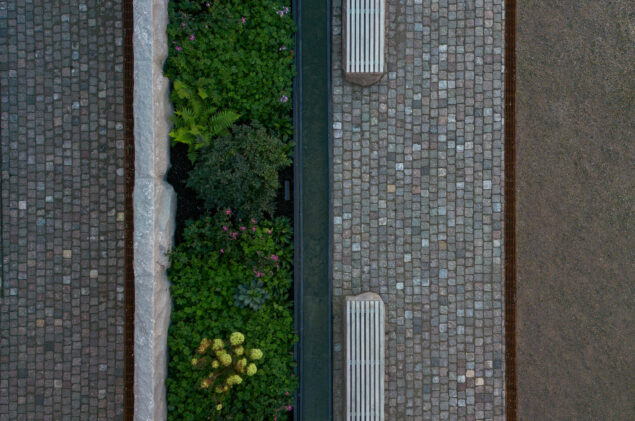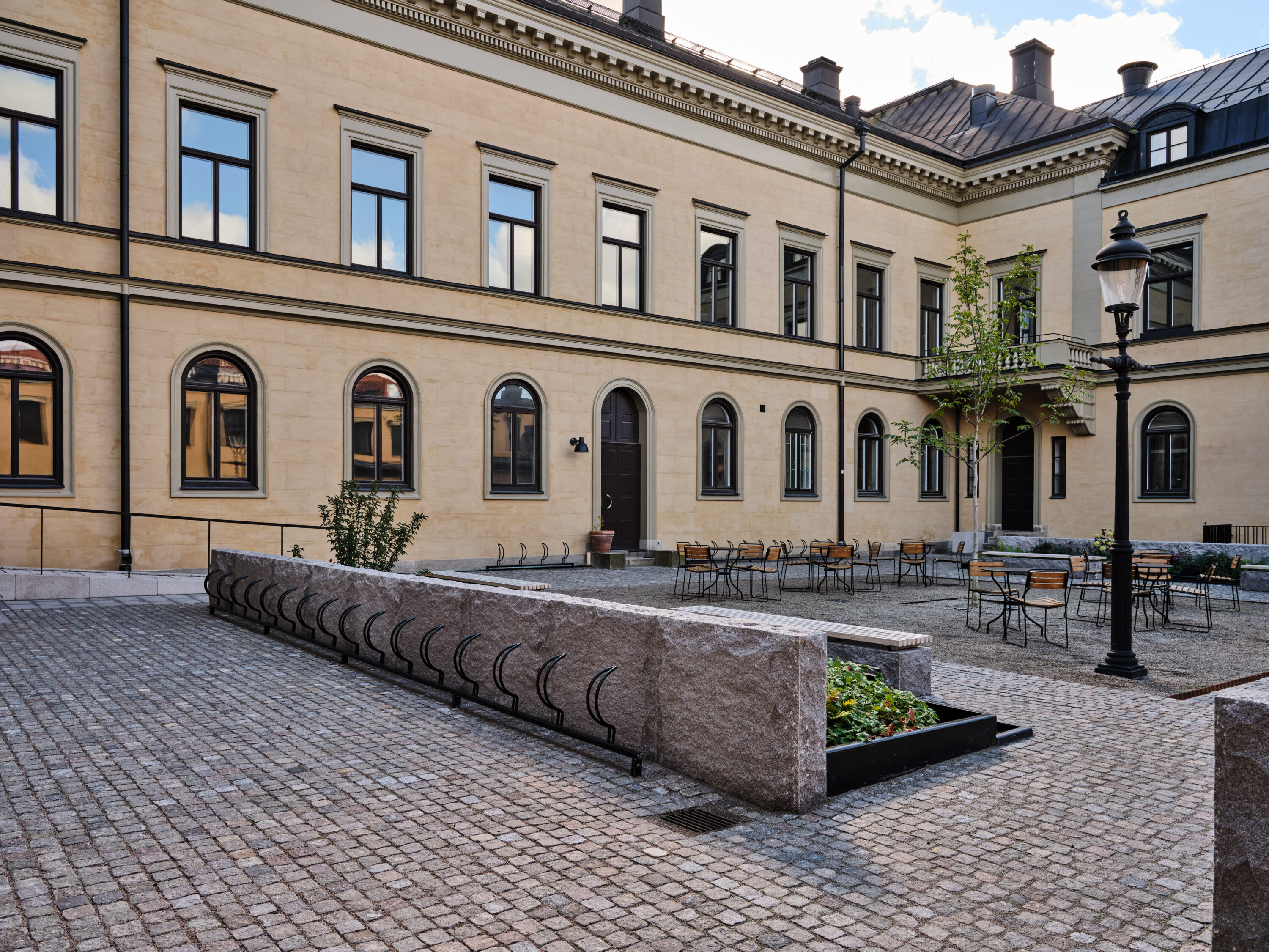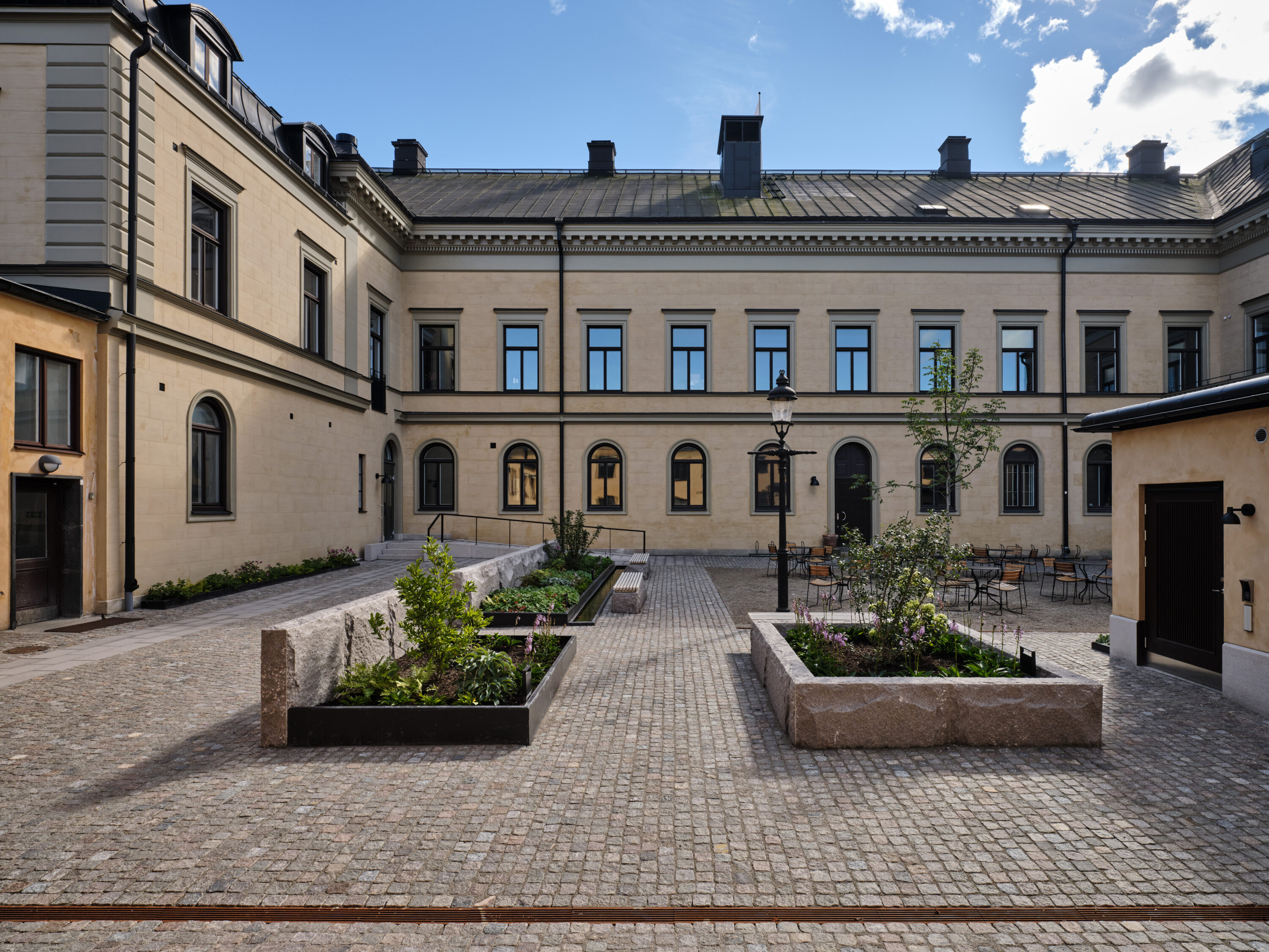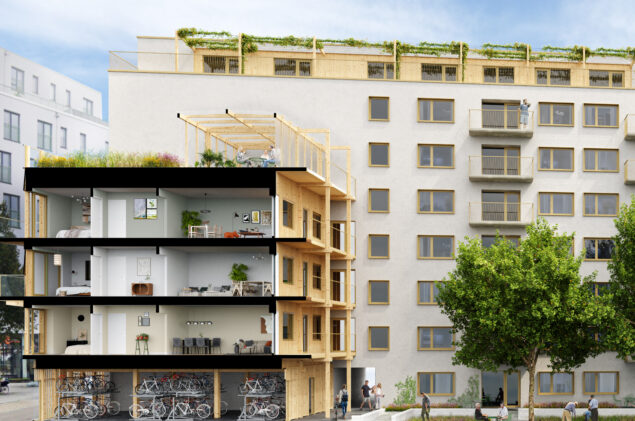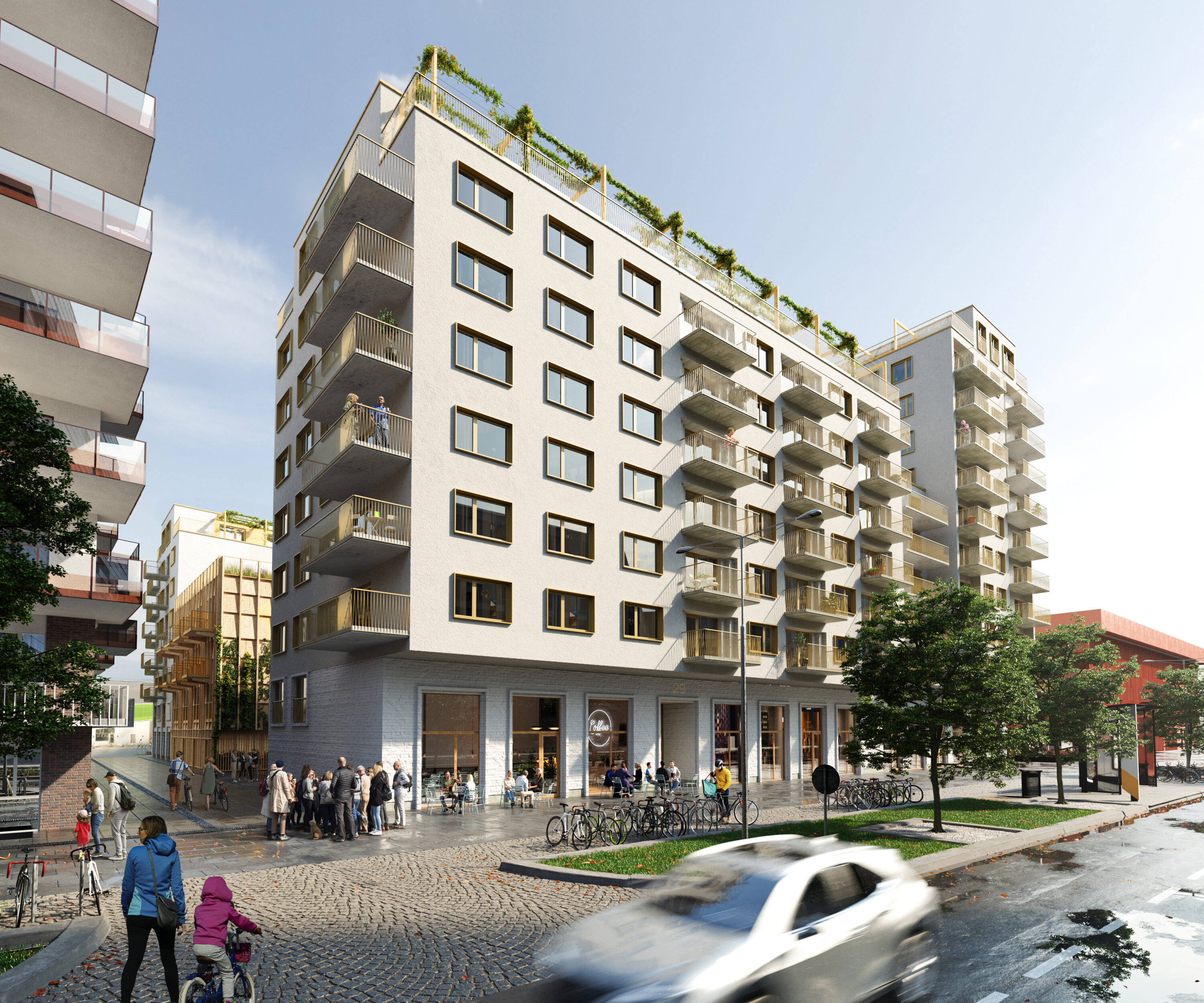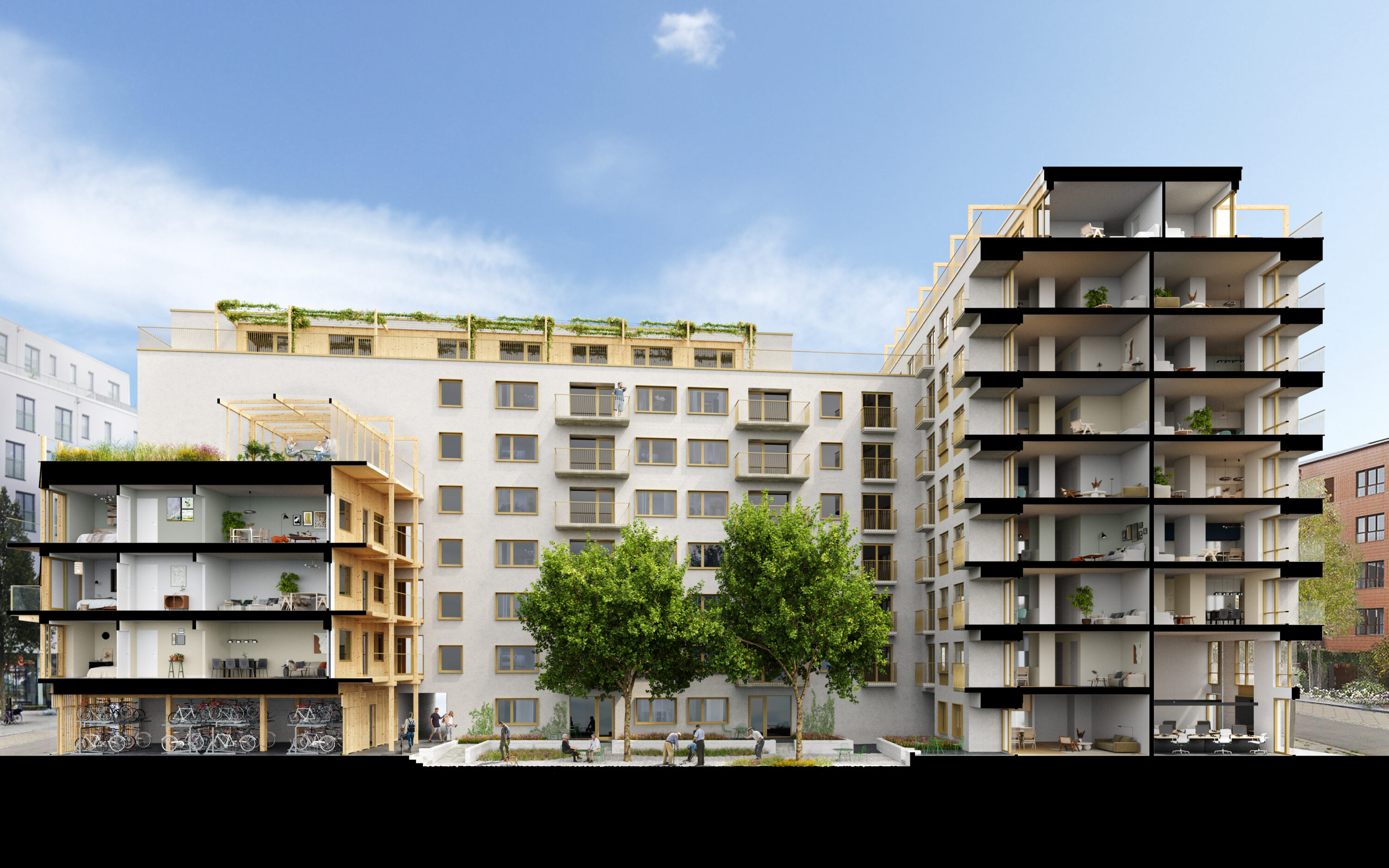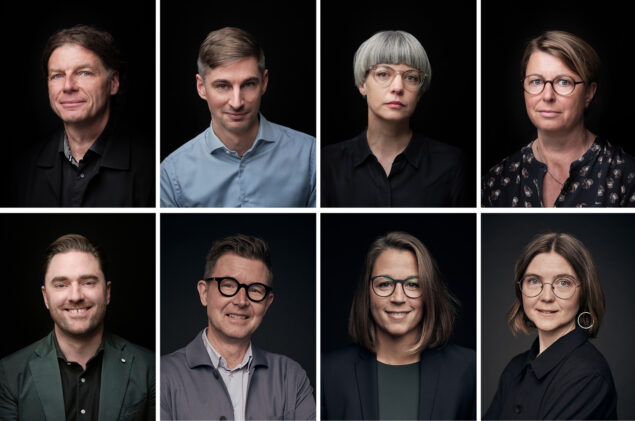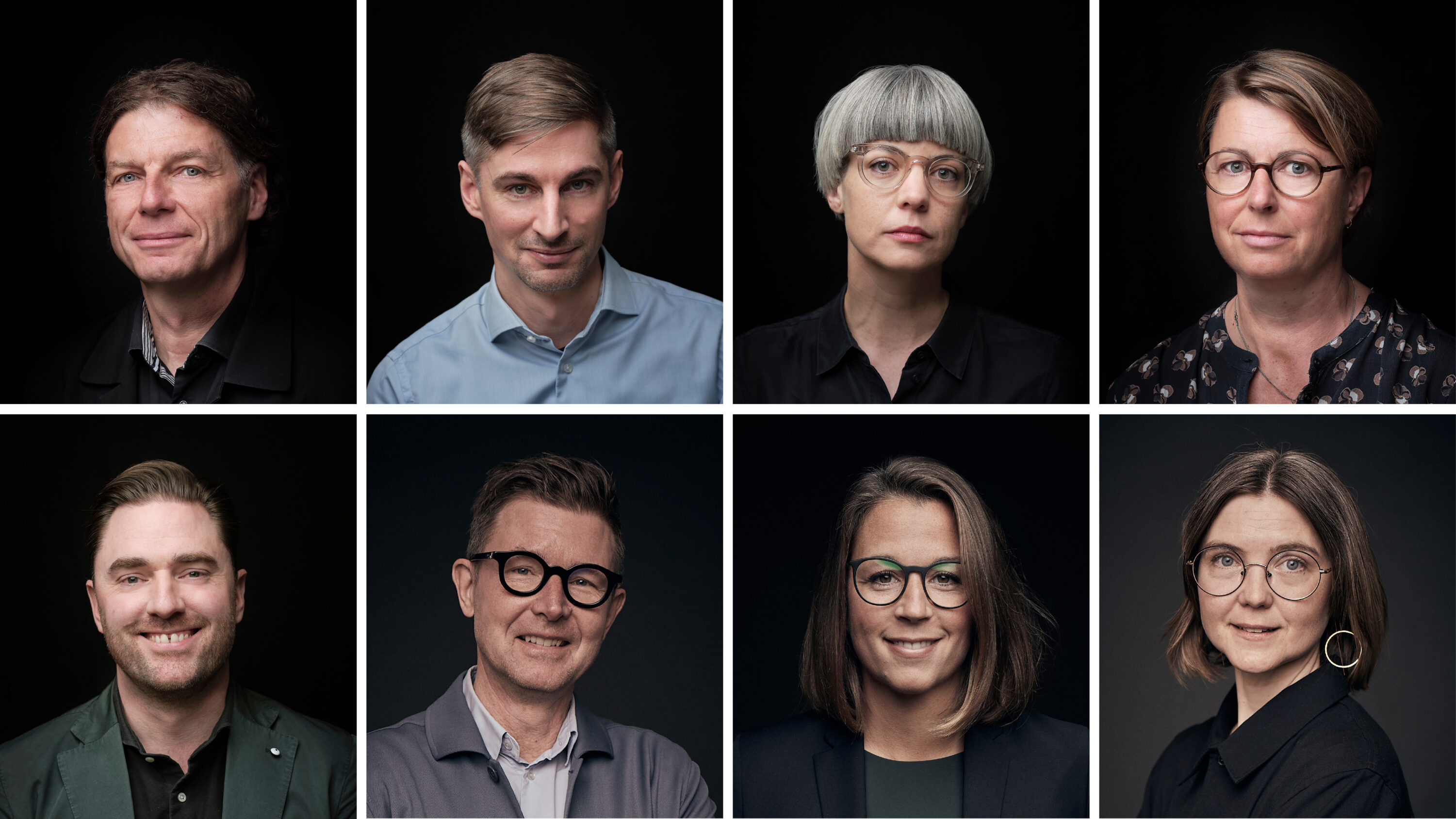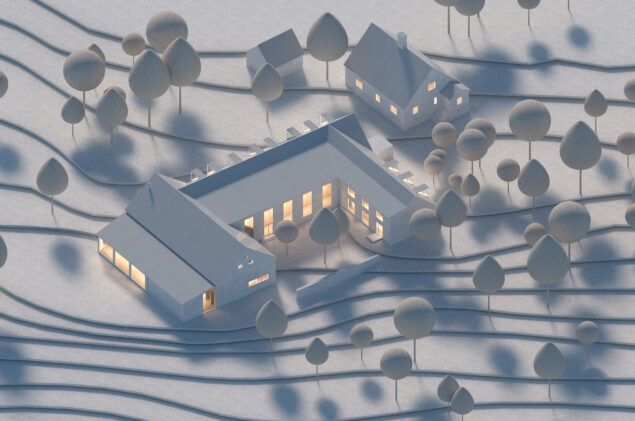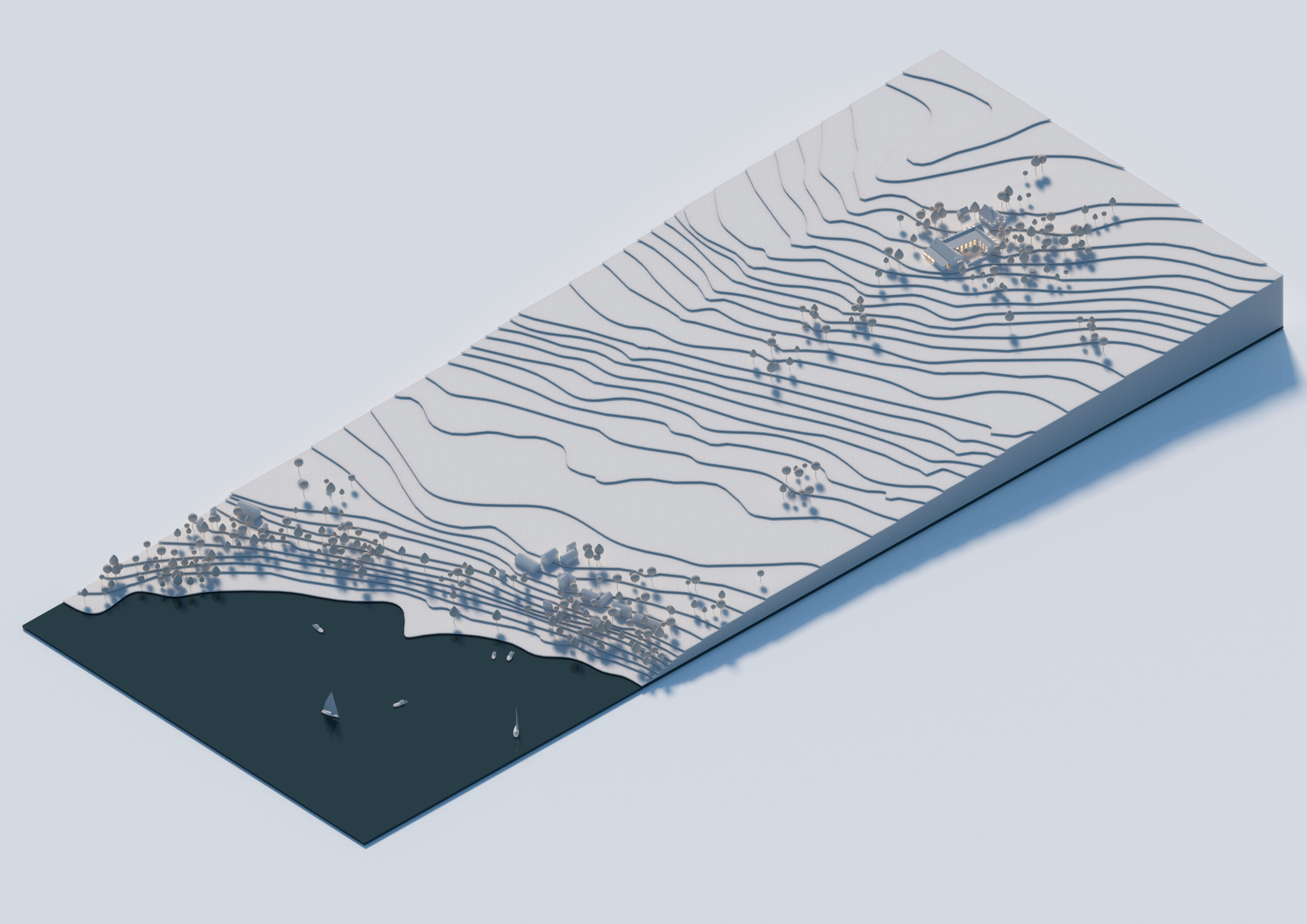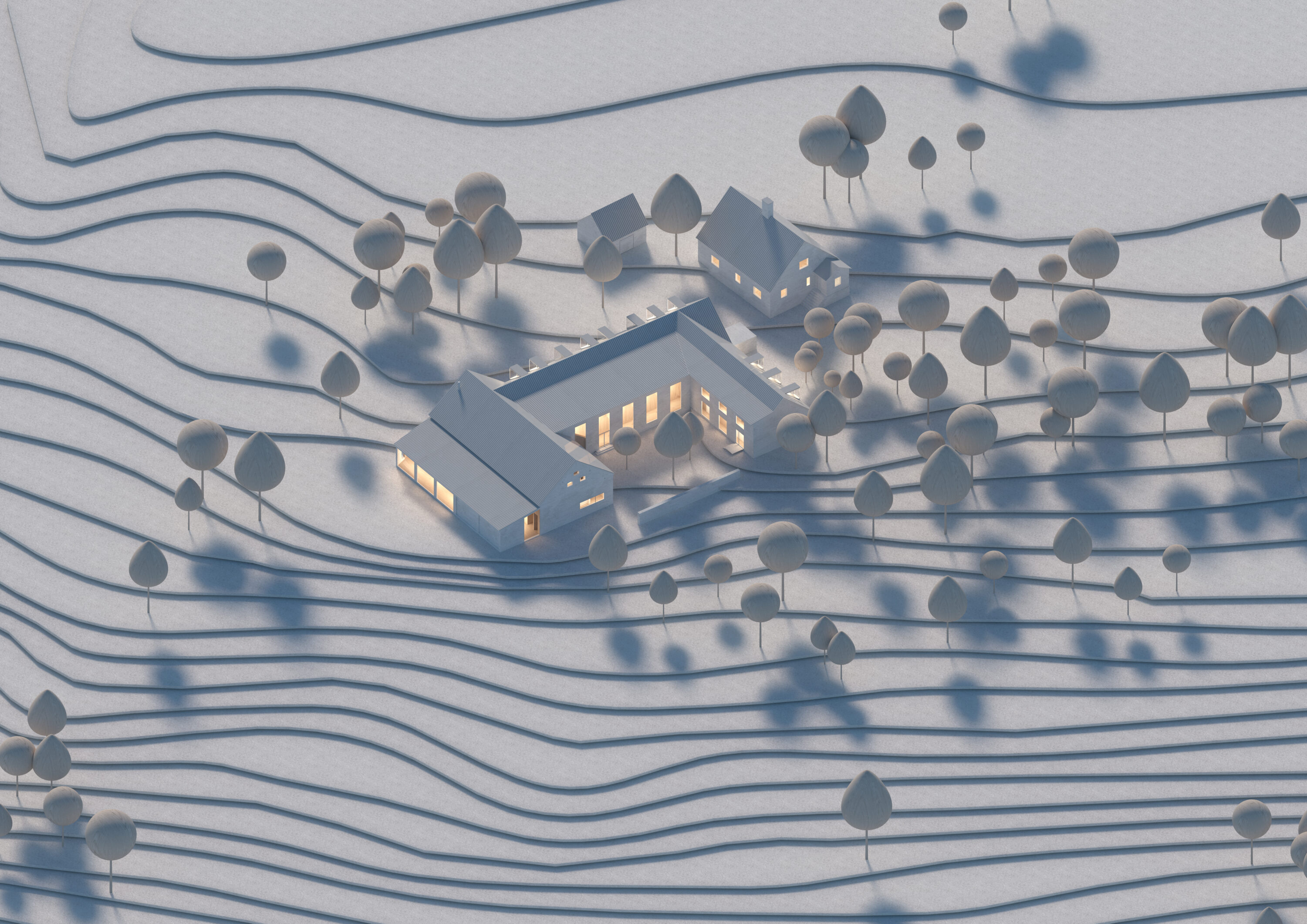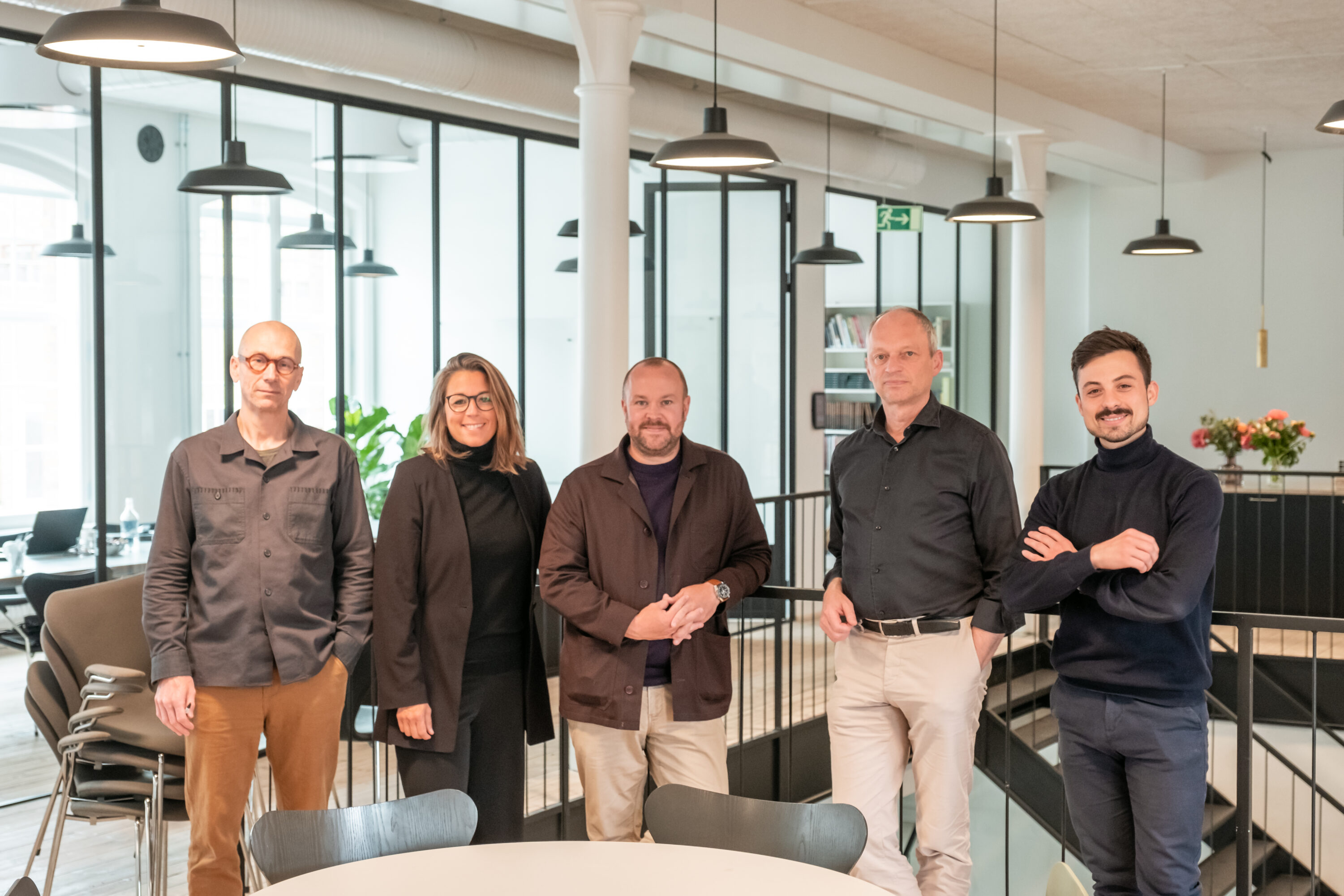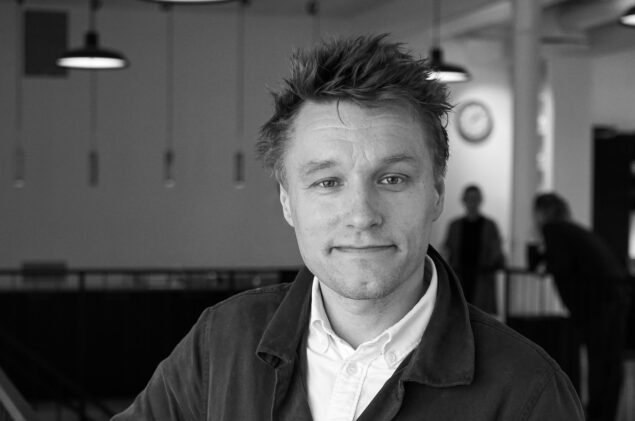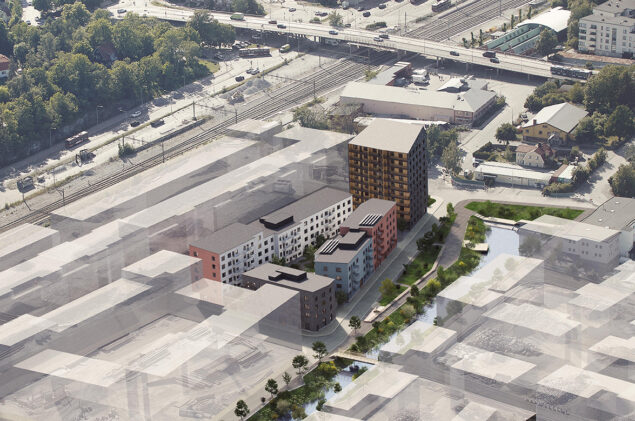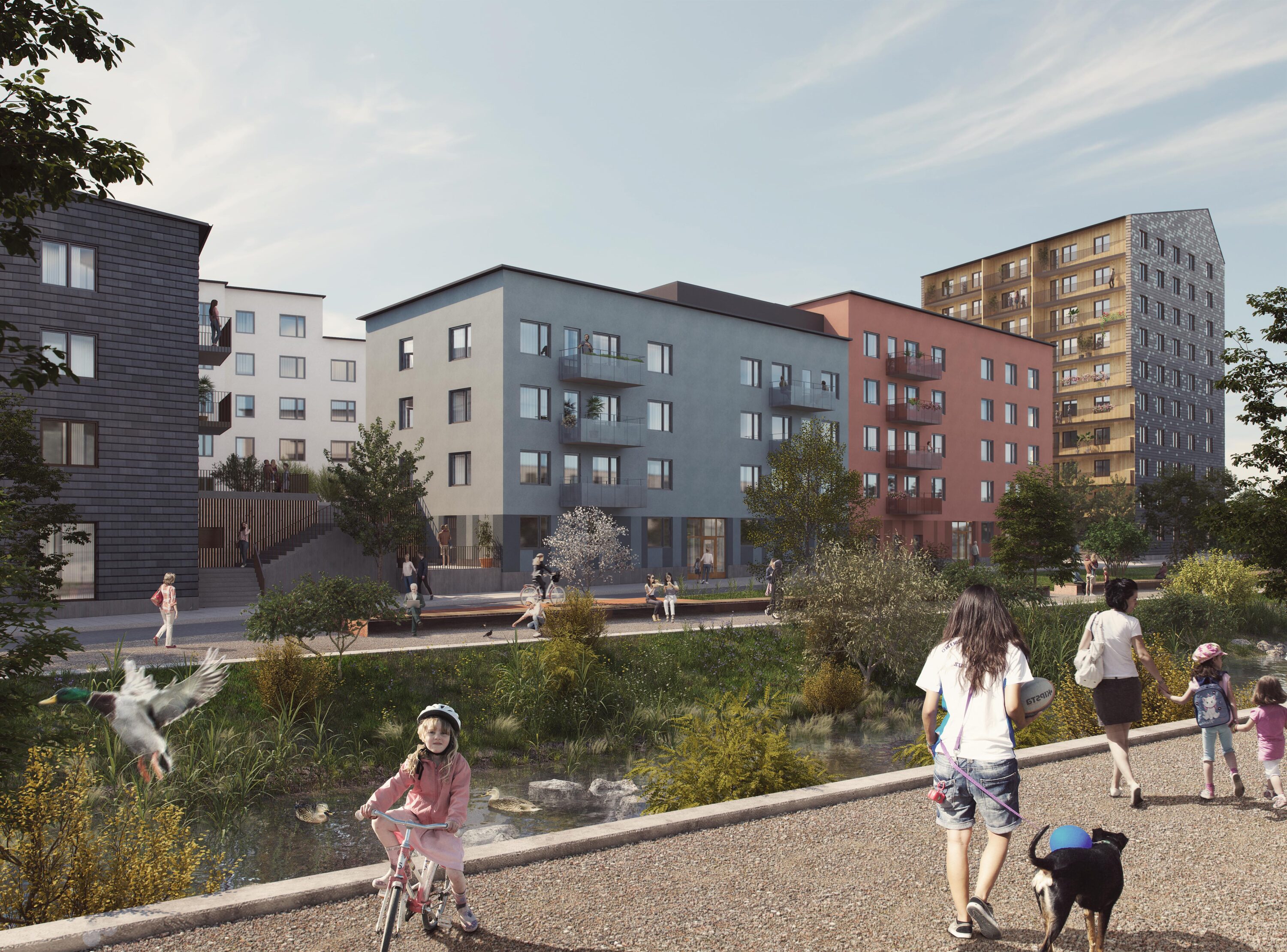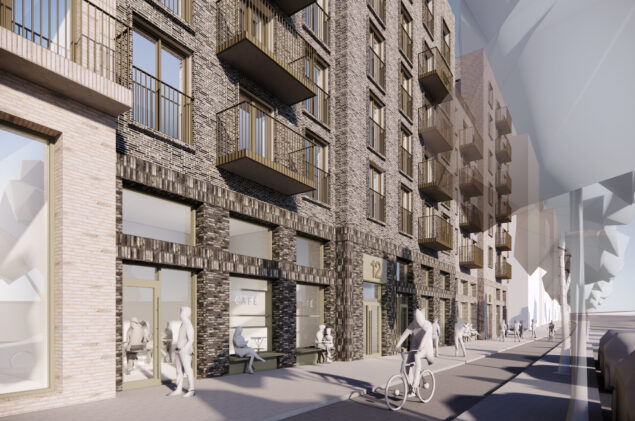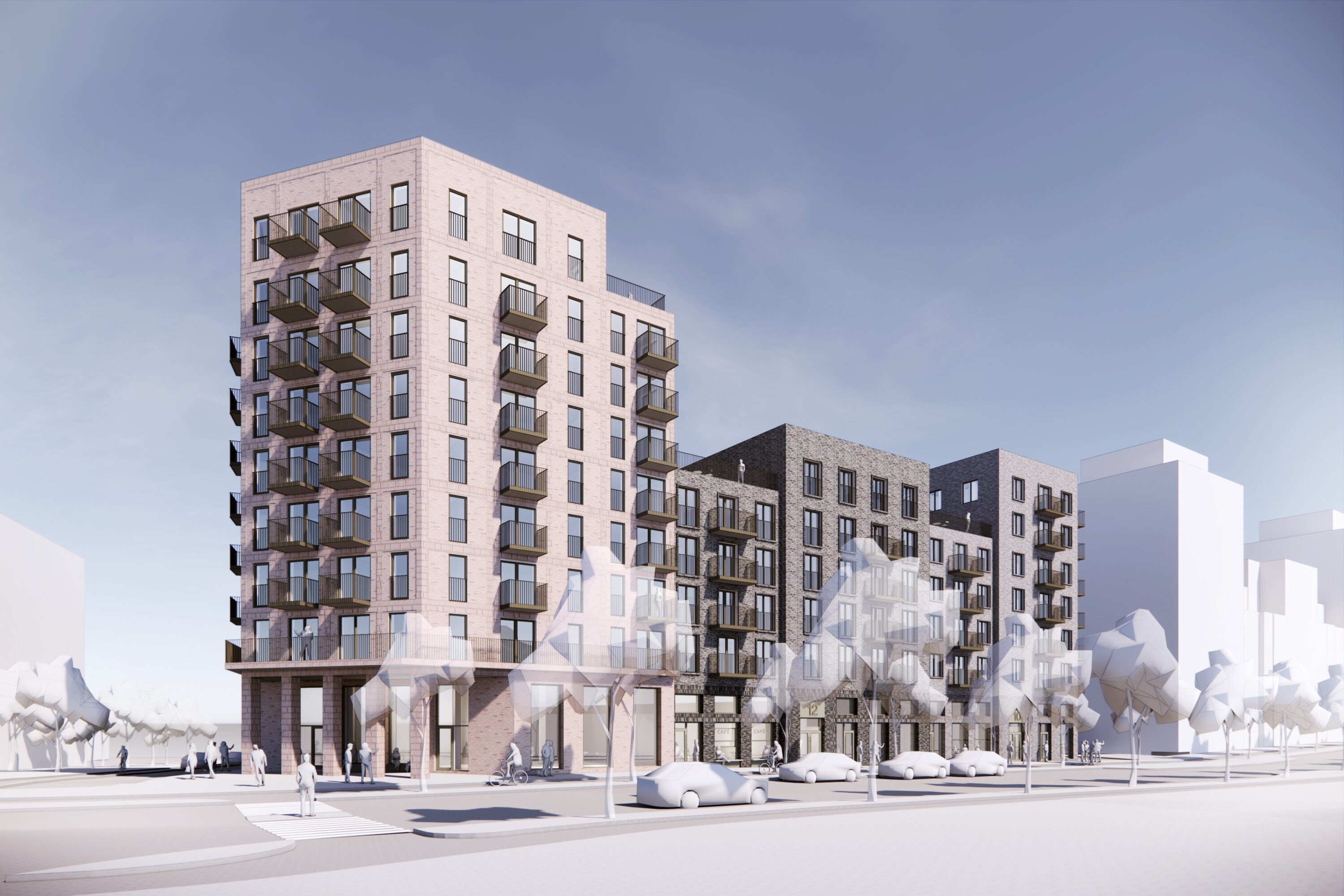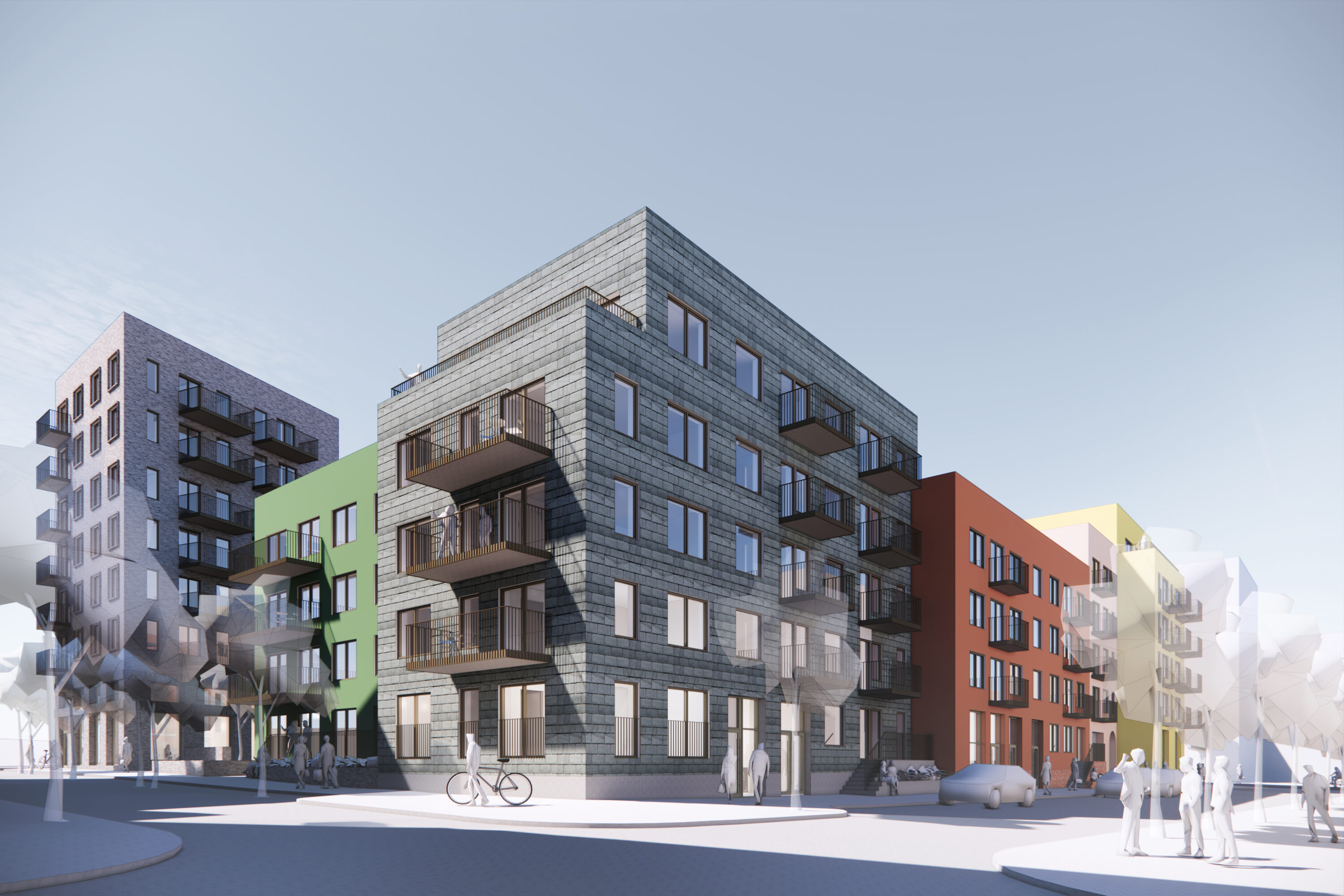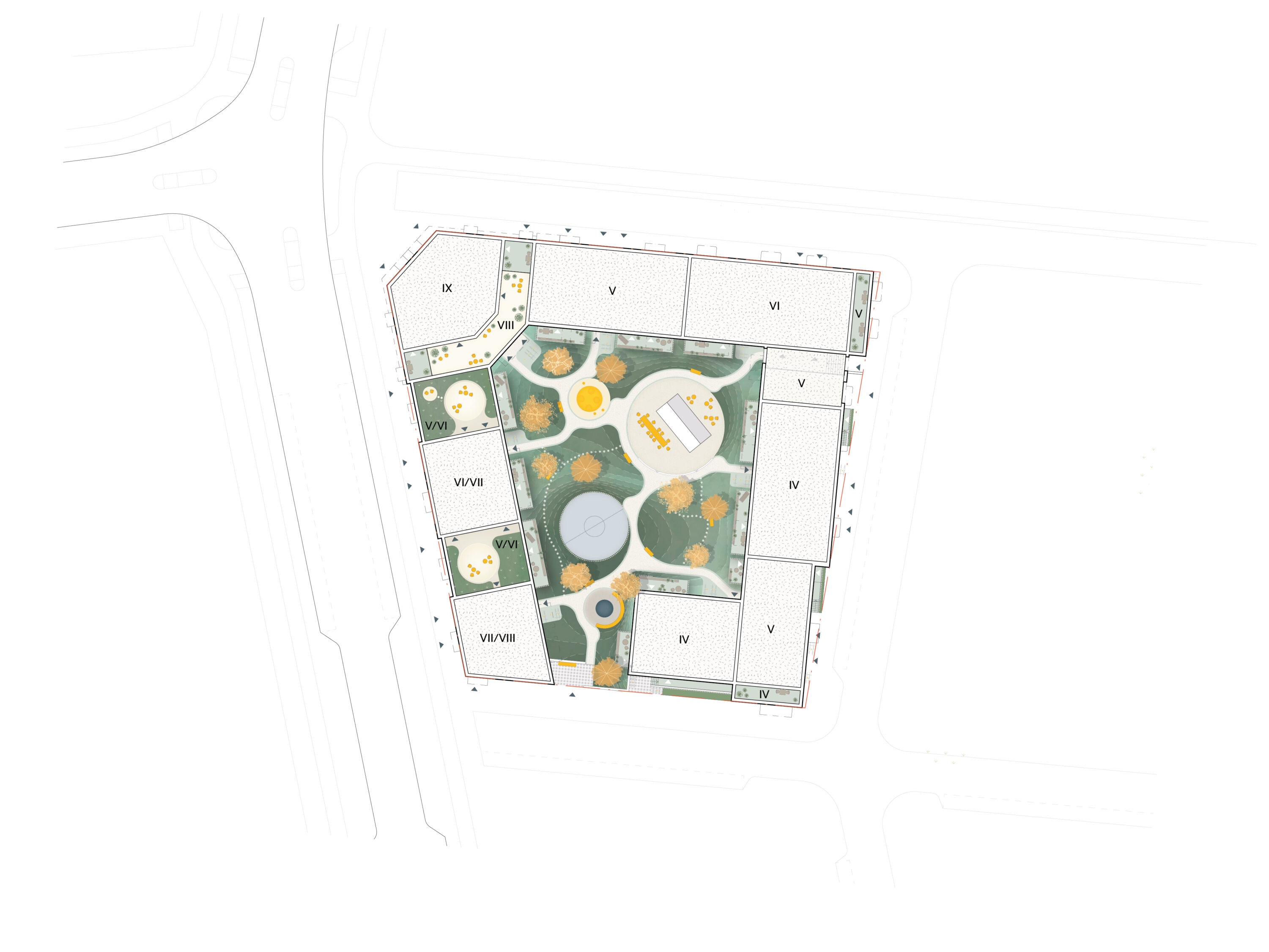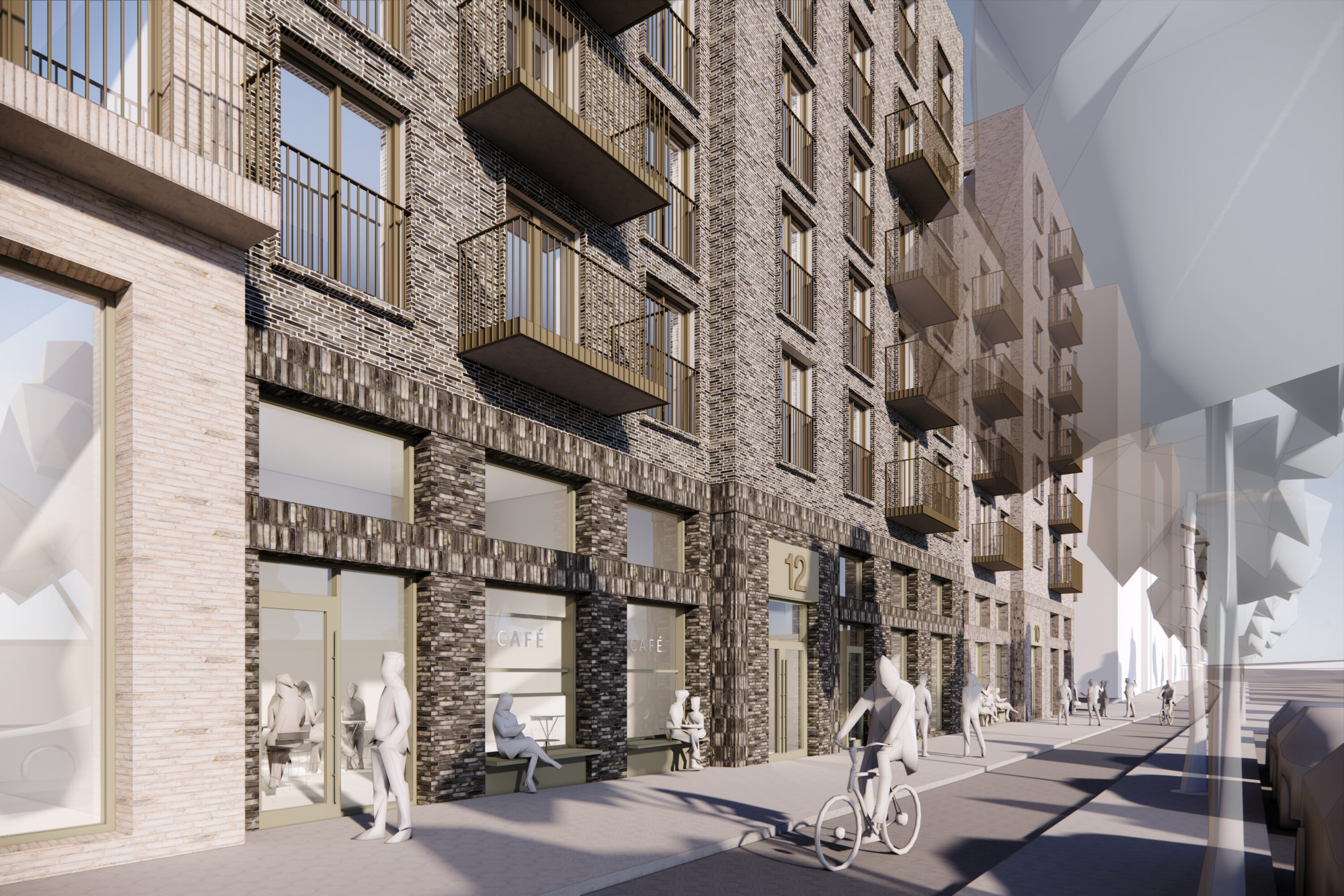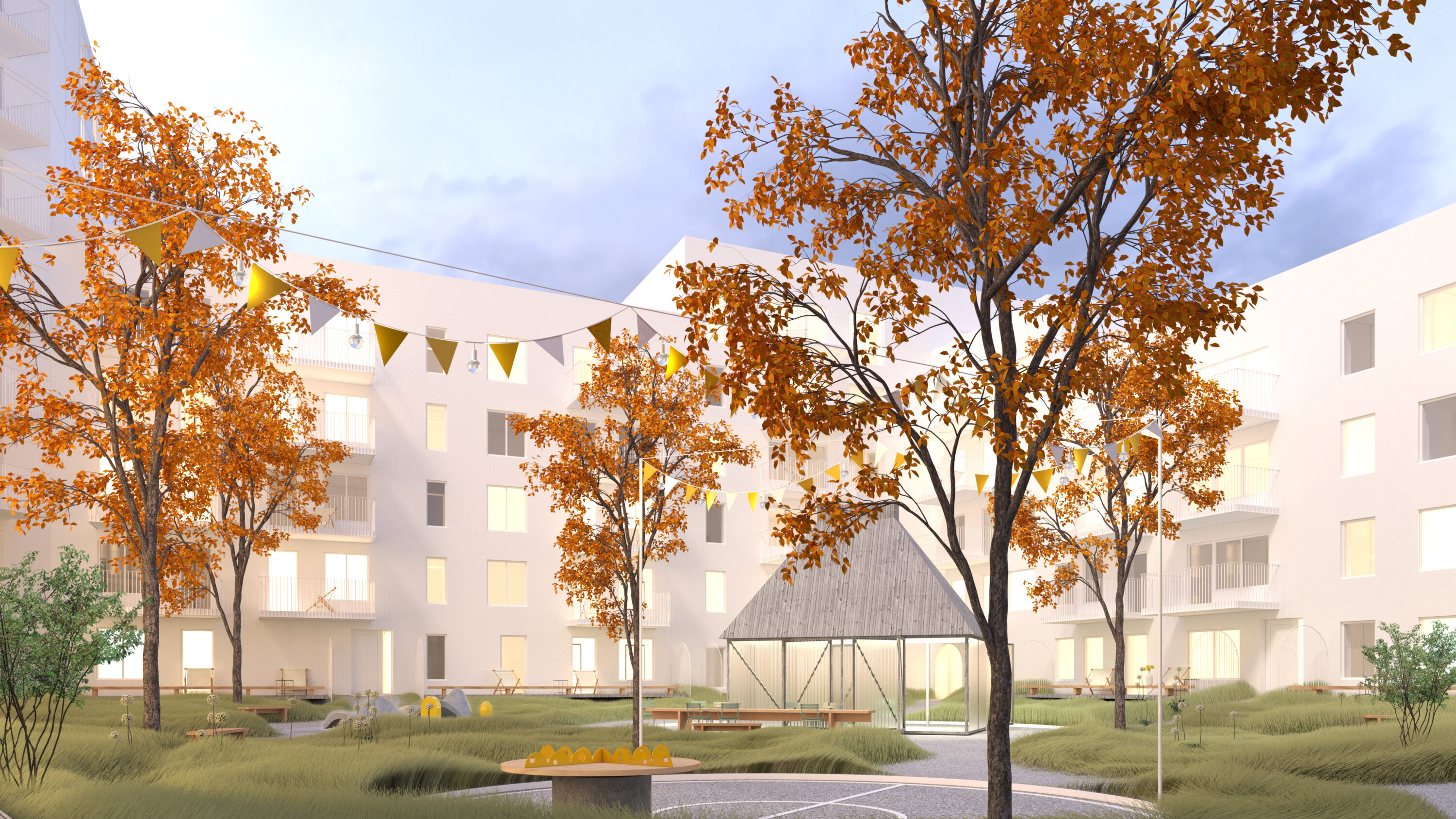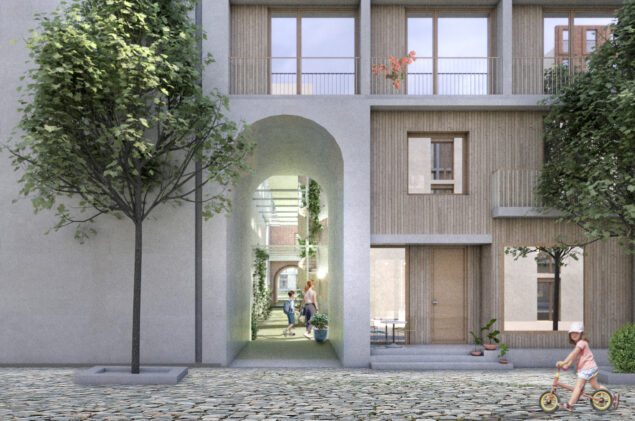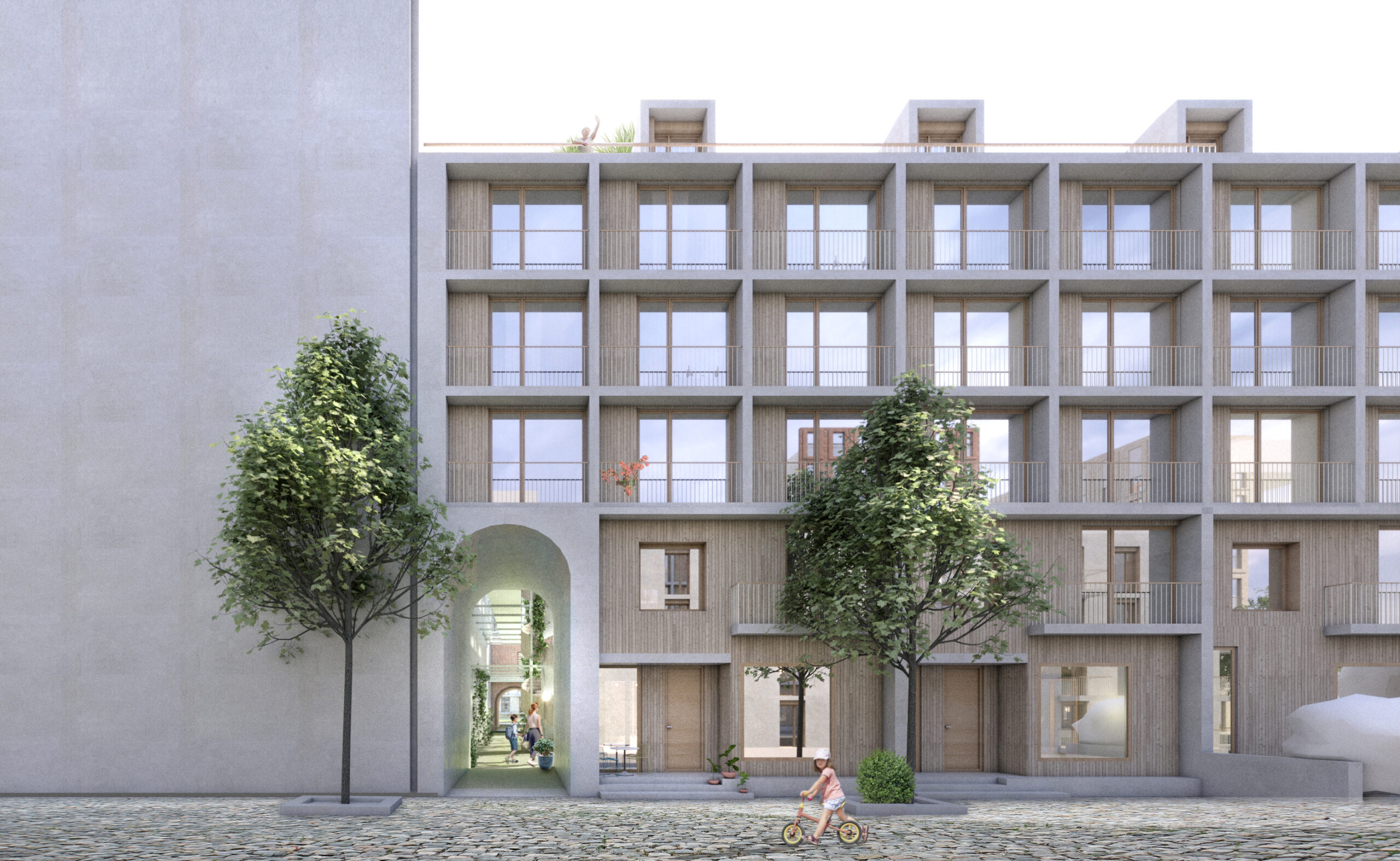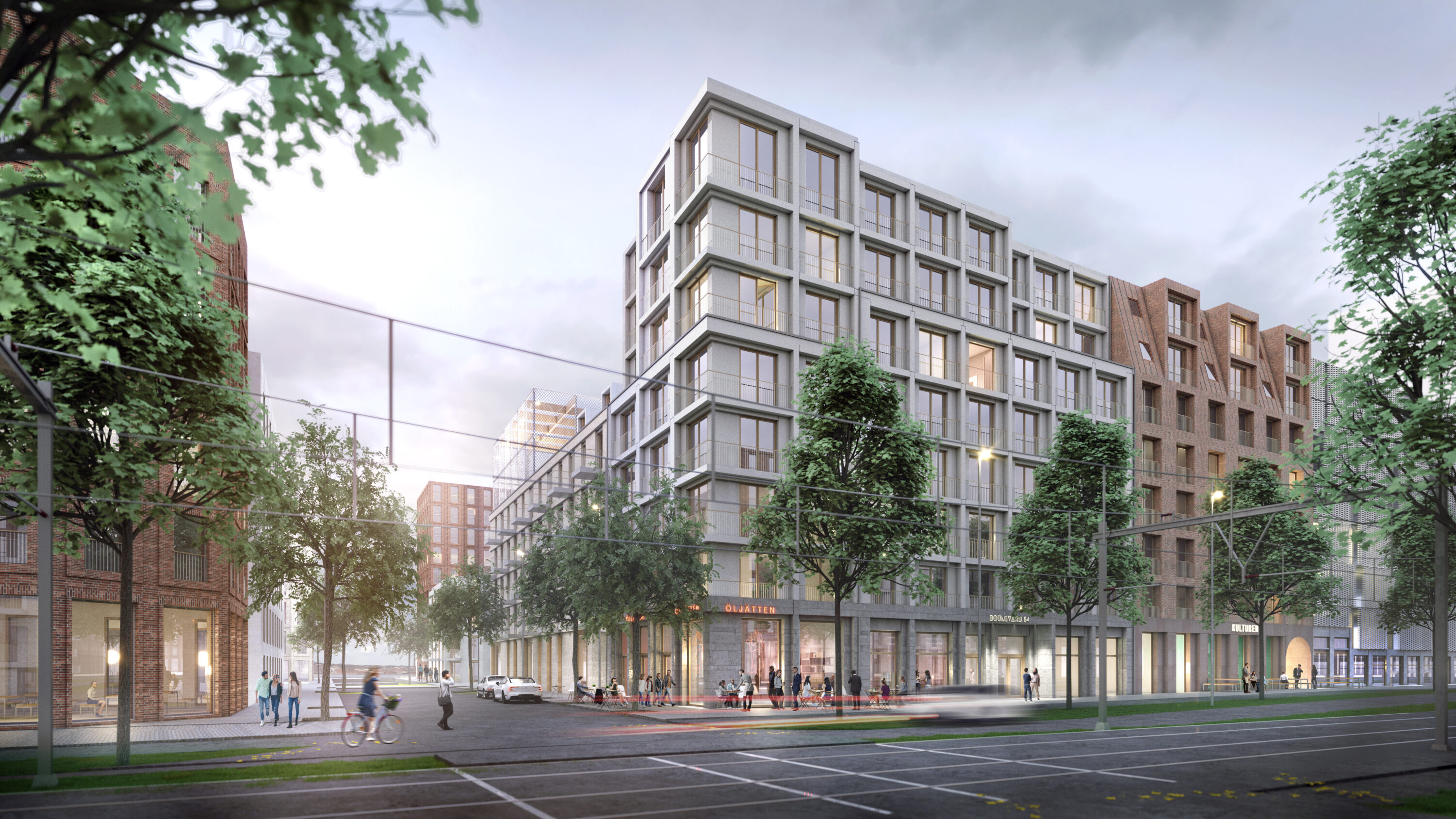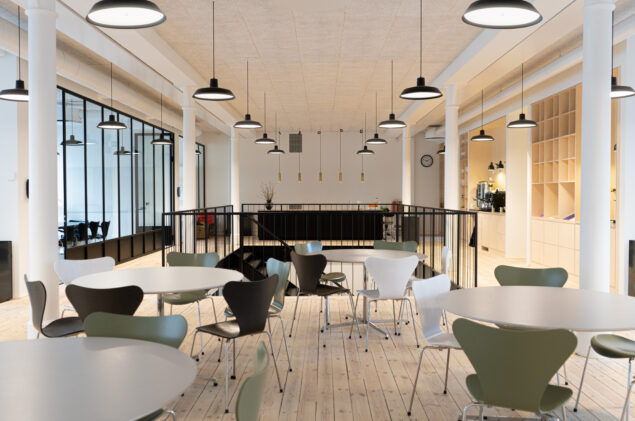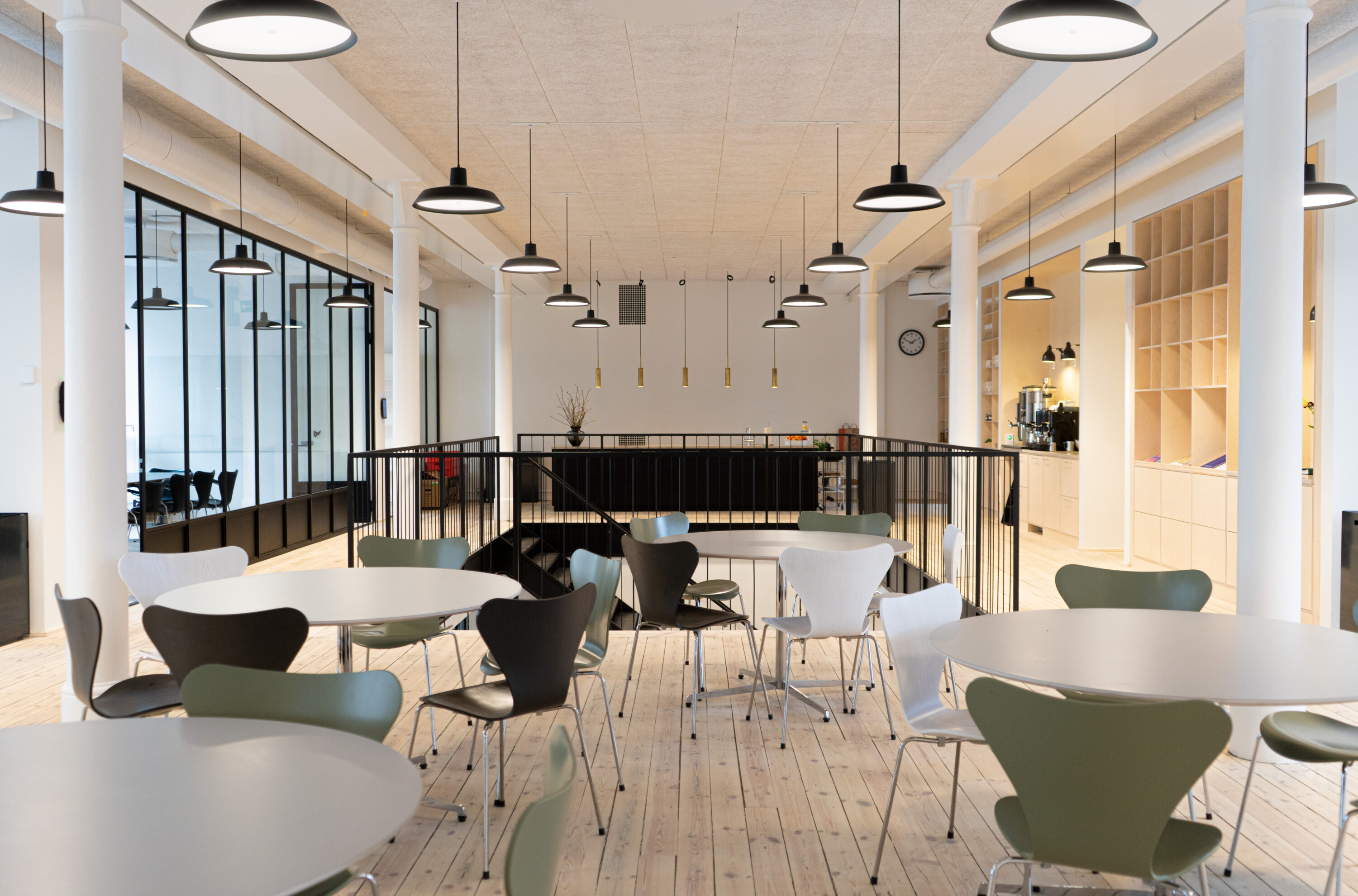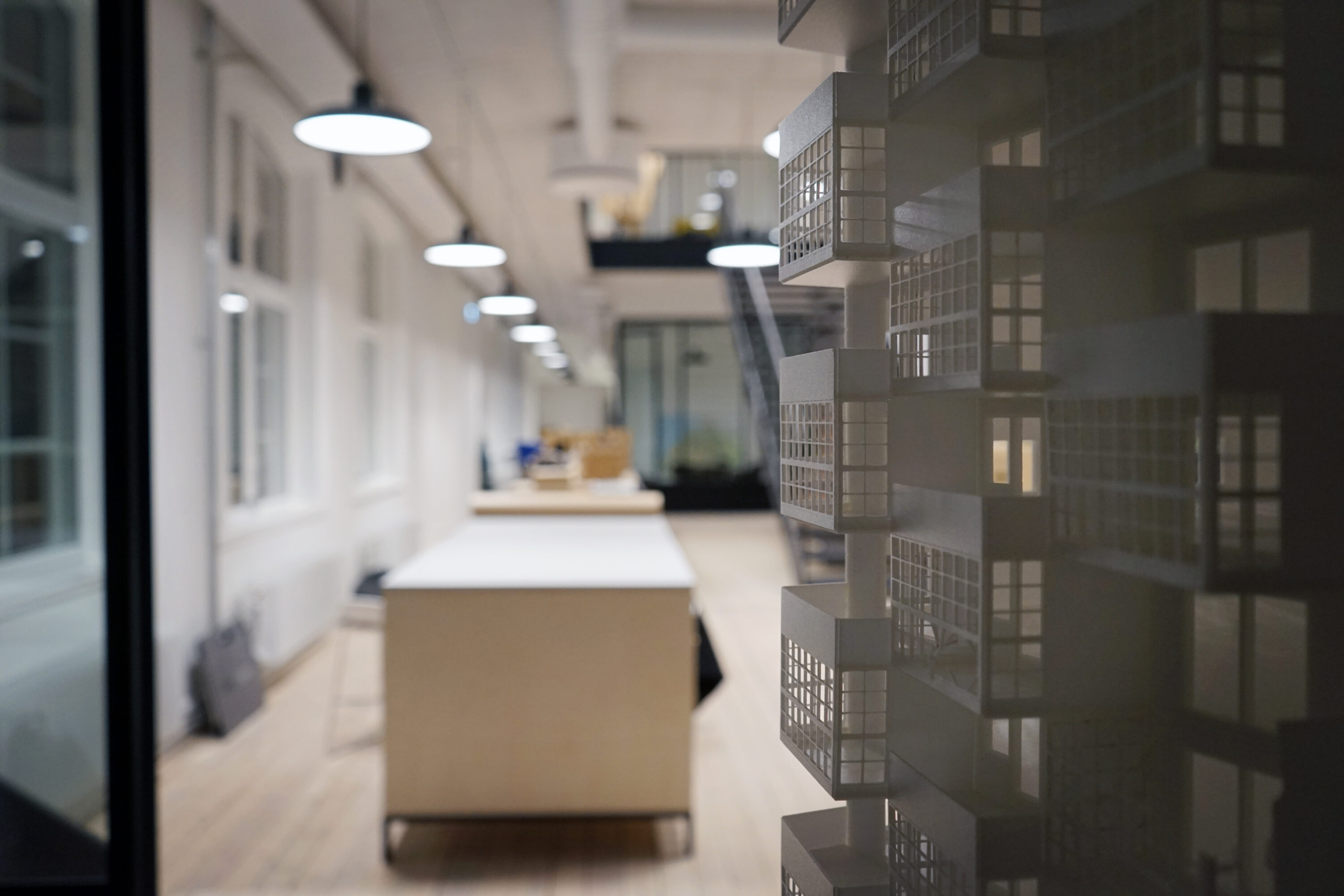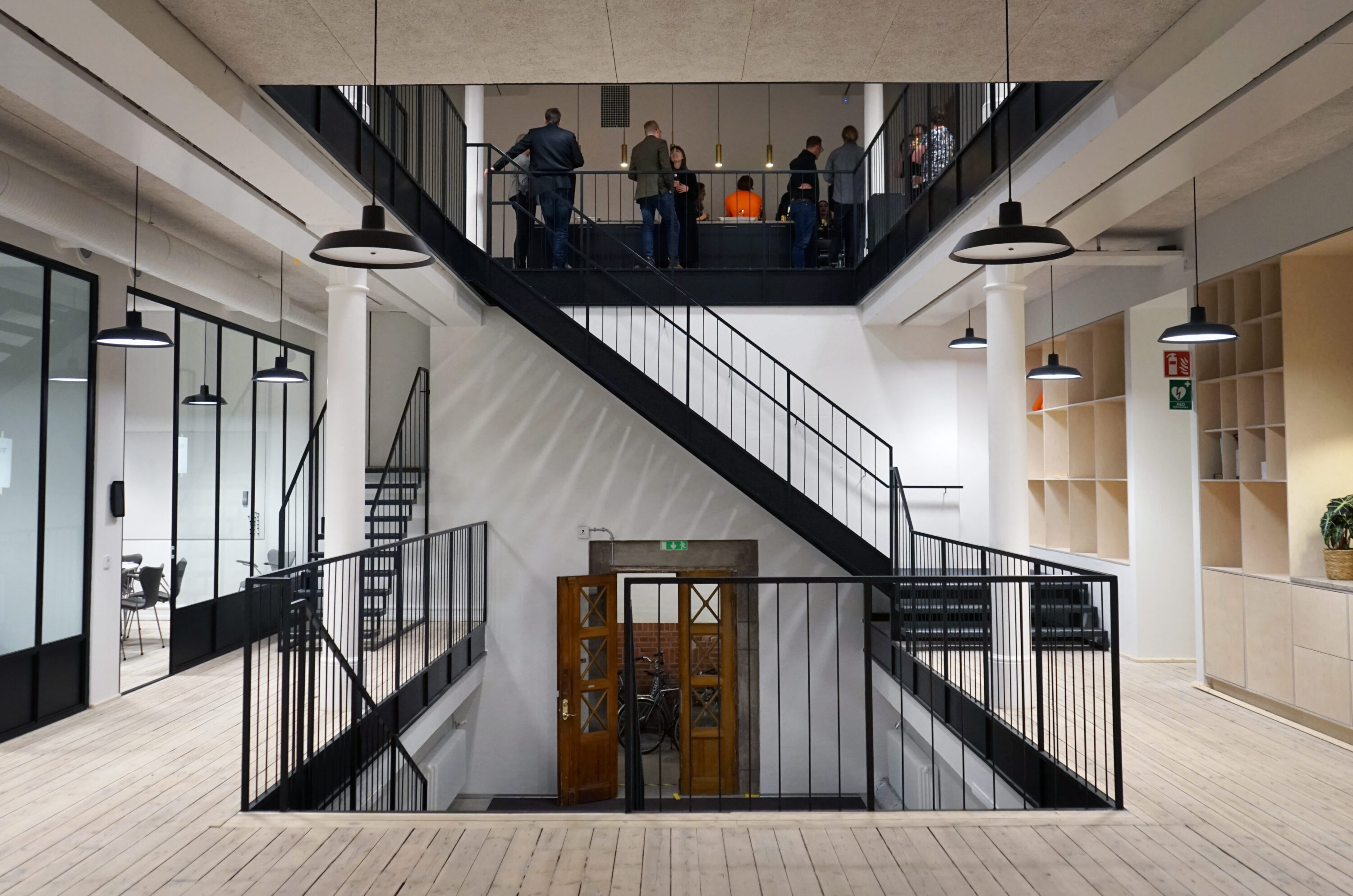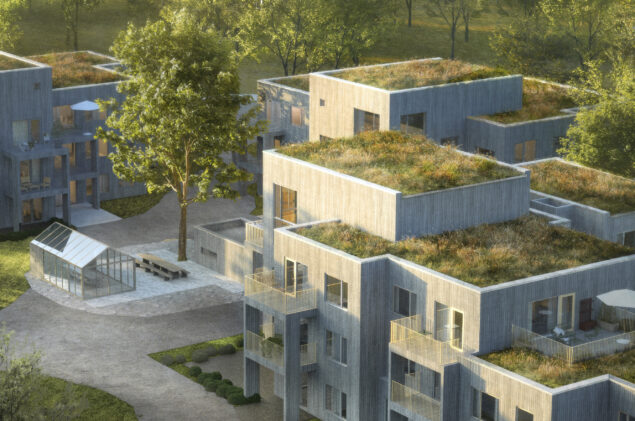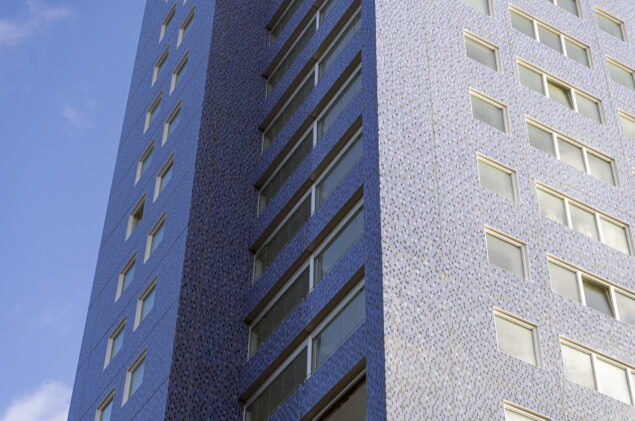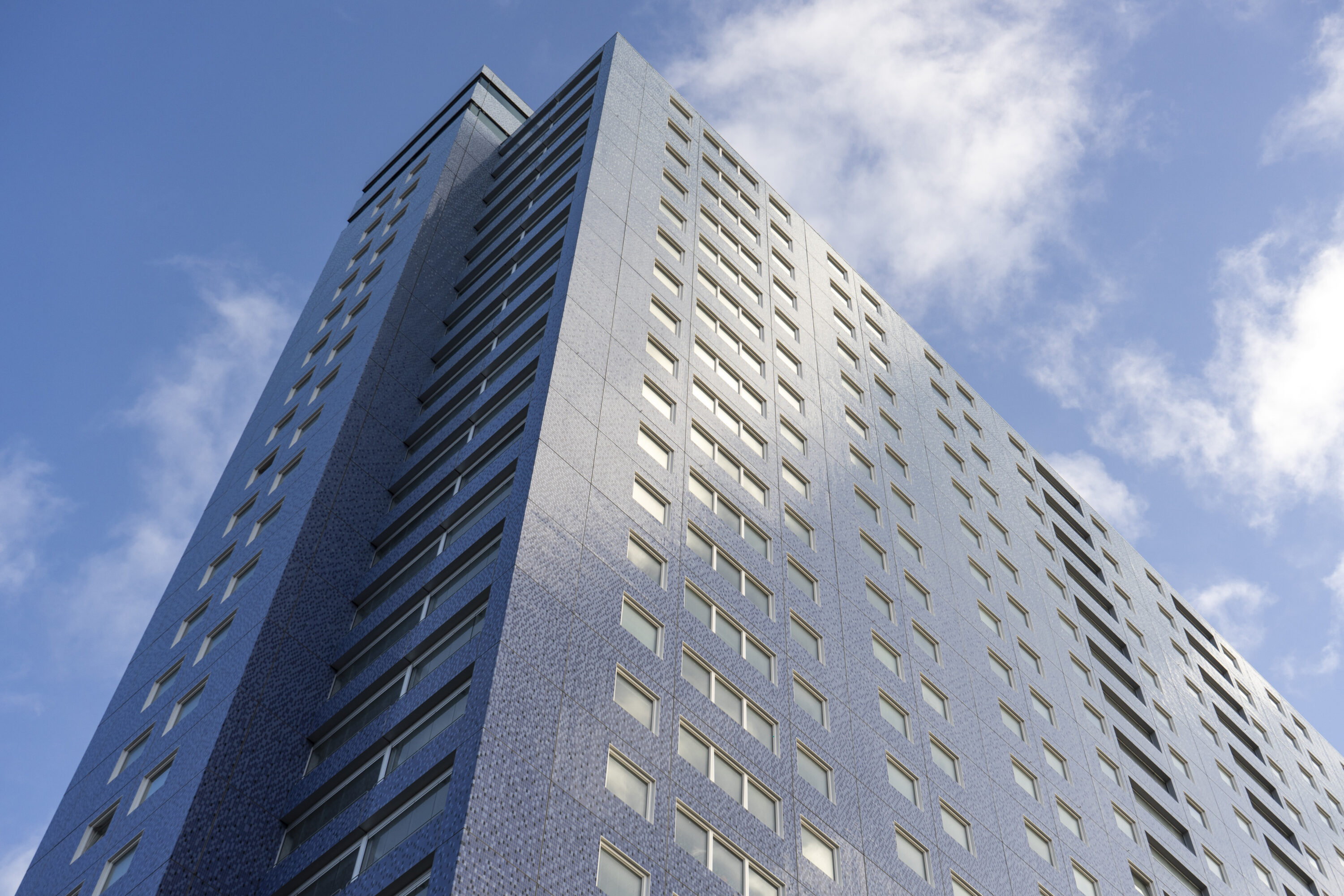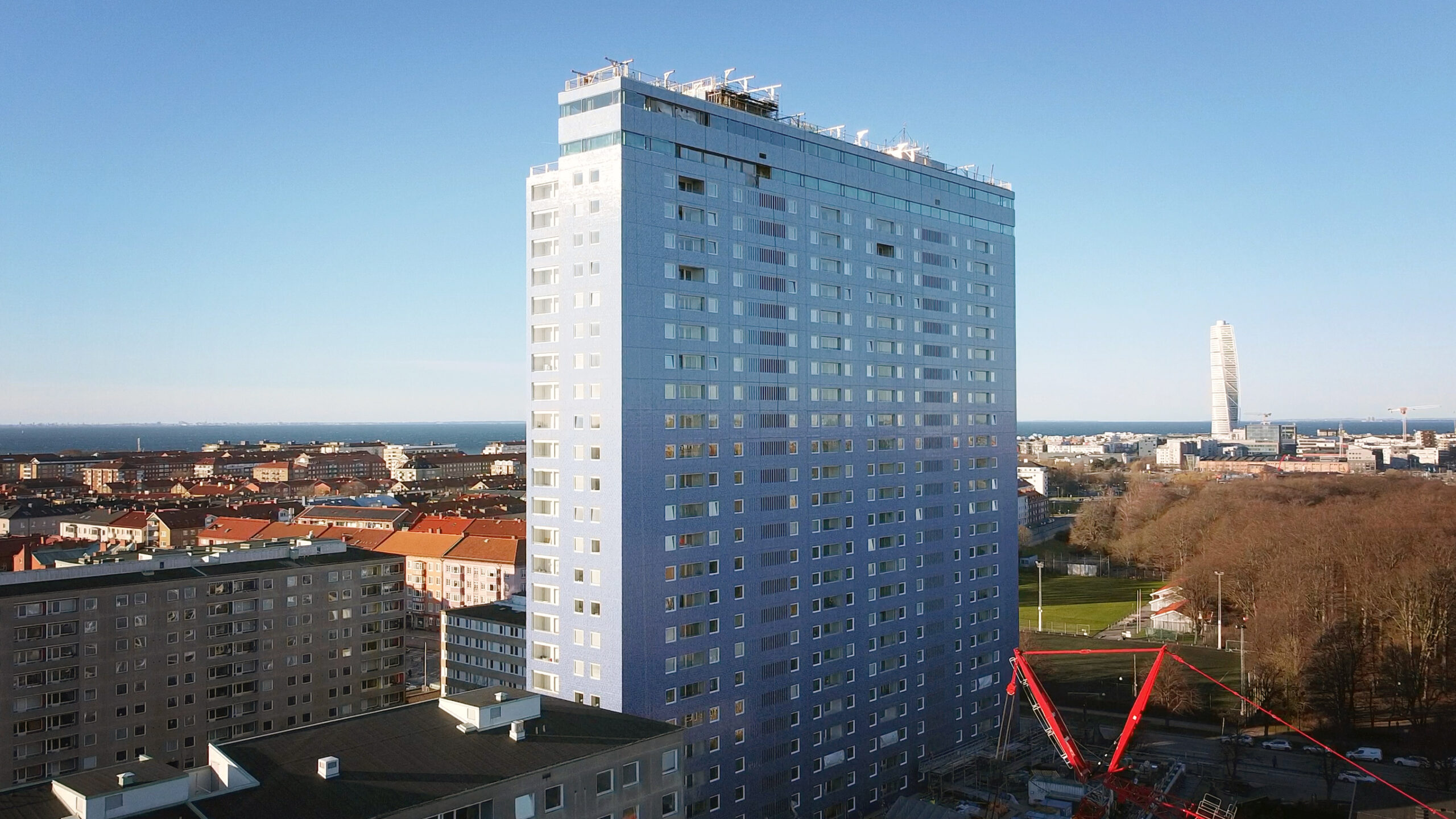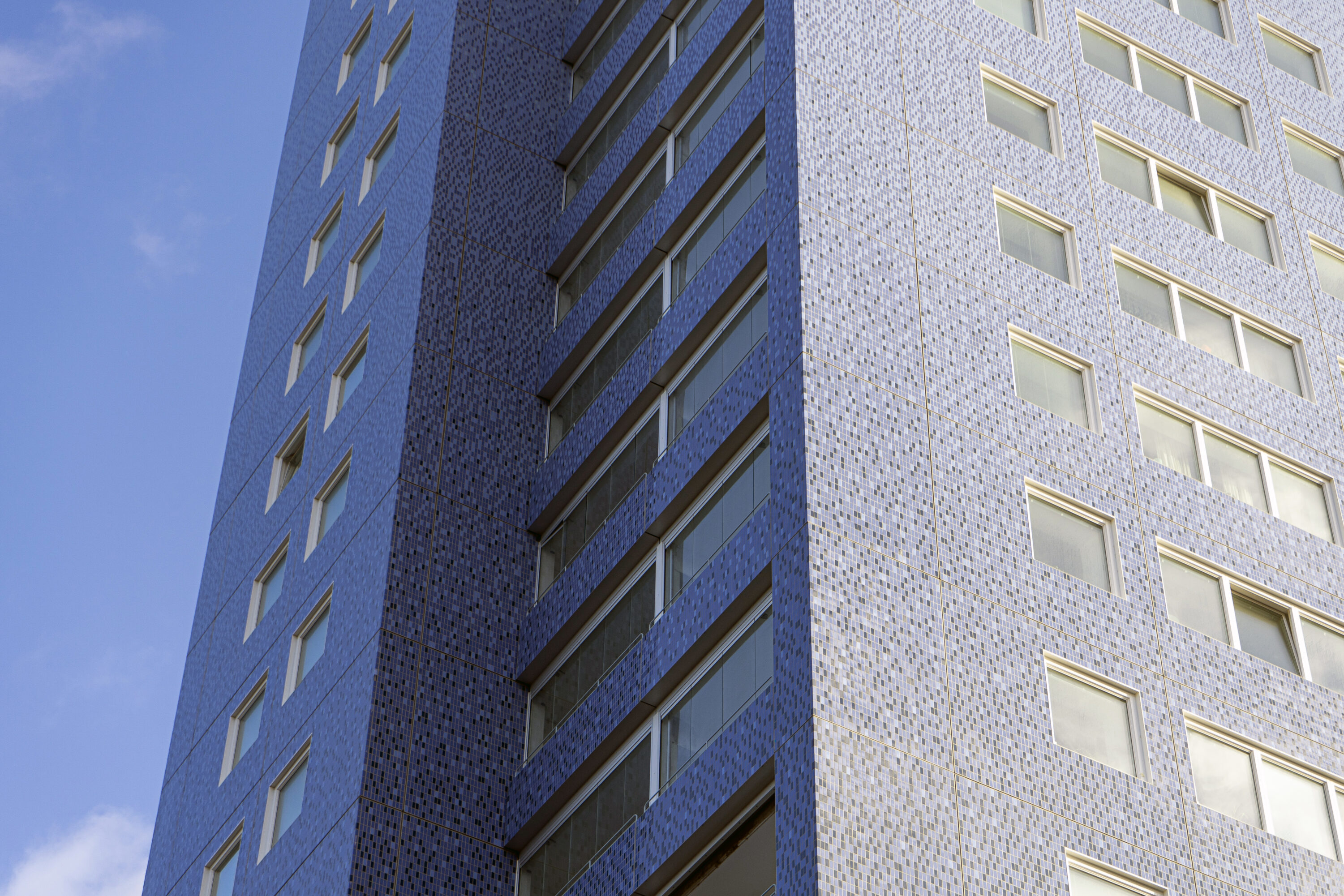2022-12-13
Theater Park receives an honorable mention
FOJAB's redesign of the Theater Park in Landskrona receives an honorable mention when the city awards its urban design prize. The ambition has been to create a safer, more attractive and more vibrant park with a clear focus on climate action.
Teaterparken is a centrally located park in Landskrona with a classic design language and historical roots from the time when the site was part of the defense facility around the castle. Despite renovations over the years, the park has been relatively unused, with the exception of a large playground.
Landskrona is expected to grow to the south and in the city's investment in the city center, a rethink and a refurbishment of the park has been prioritized. With FOJAB's proposal document as a starting point, the park has been given a clearer structure with rooms for various activities.
Around the theater building, there is now an open space for activities and events with classic landscaping. Previous rainfall problems are addressed by a large open grass area that can retain water during heavy rainfall. The lawn is framed by granite benches facing the sun.
An already green part of the park has been enhanced with trees moved from elsewhere in the park, and with a rich herbaceous layer that contributes to pollination and biodiversity in the surrounding area. Wooden walkways allow visitors to experience the environment from within and exciting play equipment links this part of the park to the existing playground.
- Landskrona is a city to love and with investments and renovations of places like Teaterparken, even more pride and commitment is created in the city, says Malin Ingemarsdotter Jönsson, responsible landscape architect at FOJAB.
2022-12-08
Two new partners in FOJAB
FOJAB has been expanding for a long time, which is now also reflected in the ownership group. At the owners' meeting in December, architects Ylva Åborg and Johanna Raflund Tobisson were elected as new partners.
FOJAB is one of the country's leading architectural firms with about 150 employees and offices in Malmö, Stockholm and Helsingborg. FOJAB has been employee-owned since 1990 and currently has 30 owners. The partnership is based on business acumen and a shared basic view of architecture, fundamental values and a vision for the future of the company.
Ylva Åborg is an architect SAR/MSA and office manager at FOJAB's Stockholm office, with many years of leadership experience and a strong commitment to sustainability. Ylva works primarily with real estate development, is an experienced process manager and has always worked with business development in parallel with her architectural work. Ylva represents a holistic view and a genuine desire to look after the company's best interests. She is driven, energetic and has an open attitude combined with clear integrity. In addition to the leadership of the Stockholm office, Ylva has acted clearly on the Stockholm market.
Johanna Raflund Tobisson is an architect SAR/MSA, studio manager, responsible for the competence area care at FOJAB and to drive the work for FOJAB's investment in community properties. Johanna works with complex healthcare projects and technology-heavy buildings with high demands on logistics, connections and flows, with real estate development plans and process management of business development. She has a great commitment to FOJAB, is commercially driven and shows a strategic skill regarding internal and external issues. Johanna has a good ability to see and listen to employees and her social skills lead to developed customer relationships, both new and existing.
- The new partners are skilled architects, business strategists and good leaders with great trust from both customers and employees. They are good additions to the ownership group and will develop and strengthen FOJAB," says CEO Daniel Nord.
2022-12-01
Mobility houses that reduce car traffic
Two mobility houses, designed by FOJAB for Hub Park, will be built in Ulleråker in Uppsala municipality. The mobility houses will play an important role in minimizing car traffic in the residential area and facilitating sustainable transport for the residents.
Ulleråker is Uppsala's next major urban development project. Construction has just started and will be completed in 2035. In the meantime, the plan is to create 6 000 new homes and a sustainable district where the majority of travel will be by sustainable transport.
The first phase is called Centrala Ulleråker and two mobility houses are planned. These will accommodate all car parking for the residents of the phase, as well as for visitors. There will also be an electric car pool and the opportunity to rent a box bike, scooter, electric scooter or other sustainable means of transport.
- We have a goal for the urban development project in Central Ulleråker that 80 percent of all trips should be made by sustainable means of transport. This requires smart solutions like these mobility houses that make it easy for both residents and visitors to make climate-smart choices in their travel," says Erik Pelling (S), Chairman of the Municipal Executive Board.
The overall solution for the two mobility houses involves an integrated approach to buildings, vehicles, services and people with long-term climate-smart construction, collaboration with various stakeholders on attractive mobility offers, digital aids and behavioral change initiatives.
- The great value, as we see it, is that we do this together with our partners and in dialog with the municipality, other property owners and future users. Then the mobility houses become part of the solution to the area's need for parking, easier everyday life, coordinated logistics and movement," says Annika Fernlund, mobility strategist at Hub Park.
The mobility houses will be flexible and climate-smart buildings that respond to the area's changing mobility needs over time. The northern building will have around 120 apartments on three sides that contribute to life, movement and security. The ground floor premises provide local services, community spaces or services related to mobility. The southern building will have 35 apartments and large areas for center activities and activities.
- We have designed the two blocks to achieve the lowest possible climate impact with long-term sustainability in mind. The northern block is built entirely in wood, a material that can be easily transformed and binds carbon dioxide. The southern block has a built-in flexibility in the structure, so that it can easily be converted to, for example, housing when the need for car parking decreases," says Anders Eriksson Modin, responsible architect at FOJAB.
2022-11-23
Here is the best looking solar house!
The Solkvarteret mobility building in Malmö, designed by FOJAB, has the finest solar installation in southern Sweden! This is according to the association Solar Region Skåne, which awards the Solkvarteret the Skåne Solar Award 2022.
The Skåne Solar Award is presented annually to a building that, through concept, design or other means, has made a special contribution to increasing interest in solar power. Installations that are innovative and innovative are particularly rewarded.
Solkvarteren is a mobility building in Malmö's Hyllie district, designed by FOJAB on behalf of Hub Park. The amount of material in the Solkvarteret mobility building has been kept to a minimum. Behind a neat metal grid, a bottle-green facade with active solar cells makes the building self-sufficient in energy for much of the year.
- The future is locally produced energy. In the Solkvarteret mobility building, we have integrated the solar cells with the facade expression so that they contribute to the design. Solar cells should not spoil but beautify," says Anders Eriksson Modin, architect at FOJAB.
- Hub Park has an ambition to be at the forefront of innovative energy solutions. In Solkvarteren in Hyllie, we have begun that journey with tasteful solar panels combined with property batteries," says Tomas Strandberg, CEO of Hub Park.
The jury's verdict:
"The Solkvarteret Malmö mobility building has by far the most attractive design in the competition, while the facades cover part of the electricity needs of the building. Solkvarteret also wins with its innovative concept by addressing a societal need and showing how city dwellers can live more sustainably. A building adapted to modern urban life where cycling is given a lot of space.
The Mobility House is an excellent example of how photovoltaics can be both a natural and beautiful part of building design. It is fun and good to highlight solar panels as a building material: green panels make it extra interesting and the metal arches give a nod to Romanesque round arches. Here, a "boring" building becomes important to both the community and the city.
The jury also wants to highlight how solar cells can have a symbolic value on a parking garage. The solar block also contributes inspiration to LFM30's work for sustainable and climate-neutral construction in Malmö."
Read more about The solar quarter.
2022-11-23
"Environments that withstand the wear and tear of the eye and hand - that's sustainable interior design"
We have a future and a generation ahead of us that will not accept throwing away and replacing. So says Lisa Mannheimer, architect and head of the Interior Design competence area at FOJAB.
What is a good interior design for you?
- A good interior design should contain something for the eye, the hand and the soul. Well-designed interior environments play an important role in the development of businesses and brands. In today's complex construction and change processes, the soft values are often forgotten. The result is often generic and impersonal. The human scale, the tactile and the caring are missing.
- Investing in quality and eco-labeling in furniture and materials always pays off when you think more long-term. My experience is also that a well thought-out, long-term designed interior environment also provides a good economy, which is often forgotten when looking for short-term savings. We have a future and a generation ahead of us that will not accept throwing away and replacing. When we can create an environment that can withstand the wear and tear of the eye and hand over a long period of time - that's sustainable interior design.
- The coronavirus pandemic and social distancing, when many of us spent a lot of time at home, reminded me of the importance of the sensual and sustainable. What qualities do we want? Is it the comfortable wooden chair or the beautiful views? As interior designers, we must always look at the big picture when planning our interior environments. The pandemic has brought about a change and shift in values and made it even more important to create beautiful and functional everyday environments. Caring spaces for the body and mind where light, materials and proportions are in balance.
Can interior design make the world a better place?
- Yes, absolutely. Our most important starting point in all design is human needs and experiences. We analyze, structure and create beautiful, functional and sustainable environments that also show attention to detail. Rooms where people want to be, thrive and feel good. We always work in close dialog with the client and look at the special needs of each assignment. Each client is unique and our mission is to highlight the values that enhance their business. We aim to work with long-term solutions and sustainable materials.
What is the most important part of your job as an interior designer?
- We see our main task as asking questions, listening, watching and being curious. We look at the big picture. This means looking at projects from many angles, but always with a focus on the people who will use the environments.
2022-11-23
Johanna Raflund Tobisson on future care environments
Johanna Raflund Tobisson is responsible for the Healthcare competence area at FOJAB and leads the work to develop the healthcare environments of the future. During her years as an architect, Johanna has worked with all types of healthcare premises, but is particularly passionate about the working environments of healthcare staff.
Why are healthcare workers' working environments so important?
- Today, we architects work according to the concept of good care, known as person-centered care. This supports an approach where the patient comes first and is seen as a person with unique needs. The patient should feel involved and safe in the care situation. And for the patient to receive good care, the staff also need a good working environment where architecturally beautiful, appropriate and functional environments are a matter of course.
- The coronavirus pandemic made it particularly clear how important it is that staff are given every possible opportunity to provide good care. The opportunities to retain important skills increase, but also to recruit the best employees. By spending time in beautiful and well thought-out environments, a sense of pride in the workplace grows and a "we" feeling is created.
- Many of the components that we architects are trying to implement to make staff environments better are daylight, greenery, opportunities for meetings and knowledge transfer, but above all we want to create a welcoming atmosphere where staff feel prioritized! These components will be incredibly important in designing the sustainable care environments of the future.
Do you have any thoughts on the future of healthcare?
- Future patients will increasingly demand faster and more accessible care. Digitalization plays a major role here, and as architects we must consider how healthcare premises can support the needs of the future. Increased demands for accessibility mean that healthcare will increasingly be located where people move, for example in shopping centers and city centers.
- The elderly population is growing and more people will live with chronic and debilitating diseases. This means that home care will be an important issue in the future, not only for municipalities, county councils and politicians, but also for us architects. How can we best create housing that supports a greater need for care due to a gradual deterioration of health through aging and multiple diseases? The longer a patient can be cared for at home, the less the burden on the healthcare system.
- Designing healthcare premises flexibly is a must, as activities increase or decrease in scope or often need to move around. However, I believe that there is a limit to how flexible and general the design of healthcare premises should be, as it generates large additional costs, which the healthcare sector in turn has to pay for through high rents. Technology-intensive care, such as surgical wards and sterile technology units, have such specific requirements and needs that it is difficult to accommodate a ward or reception in the same premises. The room dimensions, heights and technology are simply not suitable for the new activity.
2022-11-21
FOJAB's Ylva Åborg joins the board of Architects Sweden
Ylva Åborg, an architect and office manager at FOJAB in Stockholm, is elected to the Board of Architects Sweden.
- As a board member, I want to ensure that sustainability issues permeate all activities. The circular economy requires a major shift in the architectural profession.
Architects Sweden is a professional and trade organization for all architects in Sweden who work with interior design, buildings, landscape or planning. With nearly 14,000 members, Architects Sweden organizes about 90 percent of the total architectural profession. At the AGM on November 20, a new board was elected.
As a member, Ylva Åborg wants to work towards making the circular economy the clear objective of the union.
- Our industry is facing a paradigm shift that requires huge changes for us as architects, in our role and practice. In such times, it is important to work together as a body, so that we can jointly take the lead in the development of a circular economy.
- We have had a hundred years of focusing on new production, but now we must switch to preserving and refining the current stock. Here, Architects Sweden has an opportunity to pave the way. It is about how we use our common resources, how we work towards politics and how we are seen as a union in the public debate and in the industry context. The sustainability glasses must always be on.
- The economic situation also creates tough challenges that we must face together. The radically deteriorating conditions for the construction industry as a whole also make demands on our union's ability to adapt, but above all, the role of the Swedish Architects as a trade union is particularly important.
Ylva Åborg leads and develops the work at FOJAB's Stockholm office. The office has grown steadily since its inception in 2013, and since Ylva took over as manager less than a year ago, it has gained market share in the Stockholm region in sectors such as knowledge environments, community properties and sports & health. The focus on sustainability is constantly present at FOJAB, with the development of new tools and new methodology, for example in sustainable urban development and life cycle analysis in early stages.
- Within FOJAB there is a joy of innovation in terms of sustainability and digitalization that I want to share. To move architecture forward, we need to work together.
Facts: Swedish Architects' new board
Emina Kovacic, Chair, Björn Ekelund, 1st Vice Chair, Anna Leonsson, 2nd Vice Chair, and Members Per Bornstein, Patrik Faming, Maja Olsson, Anna Krook, My Lekberg, Valter Fredström, Mårten Claesson and Ylva Åborg. The new board will take office on January 1, 2023 for a two-year term.
2022-11-16
How is a facade made from discarded material?
A mobility house is being built in Malmö with a facade of discarded glass, leftover heat exchanger plates and skeletons. But what it will look like is unclear even at the groundbreaking. "Working with waste puts both the role of the architect and the building permit process in a new light," says Petra Jenning, architect and innovation manager at FOJAB.
The facade of the Hyllieäng mobility building that FOJAB is designing for Parkering Malmö consists of materials that would otherwise have been discarded. Glass removed from the facade of the Orkanen university building will be used, as well as plates from heat exchangers and steel skeletons from the manufacturing industry, i.e. the leftovers from punching shapes out of sheet metal.
The choice of these materials was the result of both coincidence and diligent searching. Looking for possible - existing - facade materials for an area of about 2,400 square meters was a new experience.
- 'Building entirely on what already exists is a completely new way of working,' says Petra Jenning. 'We contacted demolition projects in the region and various actors who handle waste and residual products from different industries. Stena Recycling was very helpful; they investigated which materials they receive in large quantities and which could be of interest to us. We went through their depot and literally stood and rummaged in their containers.
New requirements for the architect
The challenges of designing with waste are first and foremost about knowing which materials are available in the quantities needed, at the time needed. You have to be able to see the potential, understand the characteristics and qualities of the material.
- "We architects have to work with a greater degree of uncertainty," says Petra. "Normally, we choose materials that are ordered and manufactured according to our specifications. Here we are at the mercy of what is available. This places completely new demands on us in the design process.
It is also about understanding the opportunities and constraints at the production stage.
- In this project, we work with materials from industries other than construction, which creates new relationships and ways of working. What the companies previously saw as waste, we take care of as a resource. Success requires close cooperation, a lot of dialog and flexibility from everyone involved.
Final outcome unclear
And exactly what the end result will be, what the facade will look like, is not even known when construction starts.
- The glass from the Hurricane may break when we put it up. We only have a certain amount of tiles and cannot order more. The uncertainty regarding the cutting skeleton is about its appearance. Orders are relatively small and production is fast, so it is difficult to say in advance what the game will look like.
Challenging the building permit process
Despite the uncertainties, the project has received a building permit. For it to be granted, the availability of recycled materials must be managed by the developer, i.e. secured for the completion of the project.
- The city planning office has evaluated a mock-up presented by the applicant, regarding glass and other recycled façade materials. It gives an idea of the character of the building, even if some minor details such as the pattern of the cutting plate are not entirely clear, says Stefana Nyberg, building permit officer at the City of Malmö.
However, Petra Jenning believes that a more flexible building permit process and a more frequent dialog would be better for this kind of work process. This in turn would benefit the circular economy.
- Instead of a single decision - yes or no - quite late in the process, it might be better to have an early, more general policy decision followed by ongoing decisions on the details.
Legislation not adapted
Stefana Nyberg of the City of Malmö also believes that the current building permit process has its limitations.
- The legislation has not taken into account the problems that arise when using recycled materials. We are required by the government to make a decision within ten weeks, with the possibility of a further ten-week extension. Ten weeks are counted from the time the case is complete," she says:
- But the legislation can be changed and adapted, especially as there is a national ambition to work more on reuse and circular economy.
Some way to go
And even if laws and regulations change, there is still a long way to go to make construction fully circular, says Petra Jenning:
- Better information on available materials is needed. In the construction industry, a kind of equivalent of the Accessible Materials Block is being developed, but to achieve the climate commitments we need to use materials from other industries as well. This is of course much more difficult - although it also opens up more opportunities.
2022-11-11
Kronprinsen in Malmö has Facade of the Year!
The renovation of the Crown Prince's facade with its nearly two million ceramic tiles is awarded by Mur- och Putsföretagen. FOJAB received the construction industry's major Facade of the Year award.
Built in 1964, Kronprinsen is one of Malmö's most important landmarks. The 27-story facade consists of blue mosaic tiles in varying shades that lighten towards the top of the building. FOJAB was commissioned by the then-owners Akelius to investigate how the advanced but worn façade could be renovated, and then to design the rebuilding.
Together with collaborative contractor NCC and Fasadglas, which manufactured the facade elements, FOJAB developed a system to install a completely new facade, including windows, on top of the old one. 1.9 million new ceramic tiles were placed in a mosaic created using a specially written algorithm. This was developed within FOJAB CoDe, FOJAB's innovation platform for computational design.
The motivation for the Facade of the Year award in the renovation category was as follows:
The Facade of the Year jury is extremely pleased that the owner of the winning entry of the renovation award both chose to invest in a fantastic project and solved the financing for the effort. Now, this entry shines like never before, lifting itself and its surroundings into the future. The great end result has been made possible by a determined will, careful planning and execution along with smart, innovative solutions and successful collaboration throughout the project.
- It was a challenge to retain the unique character of the building, create an efficient process for the patterning and minimize the disruption to the tenants during the renovation. With Kronprinsen, we show that it is possible to extend the lifespan of buildings from this era and from the Million Program. We went straight to the most difficult task and we are pleased that the jury appreciates the result," says Andreas Jentsch, architect at FOJAB and the person who received the award at this year's Fasadforum.
Kronprinsen is part of a city block that is undergoing extensive renovation. Kronprinsen is now owned by Heimstaden.
Read more about the Crown Prince here.
2022-11-11
FOJAB designs Vänersborg's new district court
A turnkey contract has now been signed for new premises for Vänersborg District Court, designed by FOJAB. The design of the new court building will start immediately and construction is expected to start in the fall of 2023. Planned completion is the summer of 2026.
Vänersborg's new district court is strategically located near the railway station and will strengthen the transition between the park with its older institutional buildings and the old stone town. The design language is basically simple with a few character-creating features. The green ceramic of the façade gives the building a clear identity that relates to the city's many copper roofs and the greenery of the adjacent park.
- The ceramic panels are slightly curved, which creates effective shadows on the facade - a bit like the ripples of water on Lake Vänern. "A solution that combines beauty with sustainability and efficient construction," says Kjell Adamsson, responsible architect at FOJAB.
The court building houses around 130 workstations, 11 courtrooms, including two security rooms, security control and reception, public areas, staff offices, and transport and detention rooms. Designing a court building is an intricate puzzle. People in the building - the public, prosecutors and judges, court staff and detainees - are classified into four different security levels. Their paths must not cross on their way in and out of the courtrooms. Vänersborg District Court will have separate entrances to all courtrooms and separate flows throughout the building, with separate evacuation routes.
- "FOJAB has great expertise when it comes to court buildings. This means that we can offer Vänersborg an extremely functional district court with high architectural quality," says Hanna Tengberg, project developer at Hemsö.
The building is prepared for possible future expansion in such a way that safety zones and flows are ensured.
- Courts are installation-heavy operations and we have built in flexibility that enables continuous development and updating. Future-proofing the building is also an important sustainability aspect," says architect Kjell Adamsson.
2022-10-28
A win for a diverse and innovative city block in Karlskrona, Sweden
An expressive residential neighborhood, a green nursing home and a social mobility house. Riksbyggen, Odalen Fastigheter and FOJAB won the contract to design a city block on Pottholmen - the new entrance to the World Heritage city of Karlskrona.
Pottholmen is a new neighborhood emerging in Karlskrona. Strategically placed at the entrance, it will be the first encounter with the city. Following a land allocation competition, Riksbyggen, Odalen and FOJAB have now been commissioned by Karlskrona Municipality to develop two of the more central blocks.
The building in the winning proposal is multifaceted in both content and expression and consists of three parts: The Tower District with its housing, restaurants and outdoor seating will be an eye-catcher and an inviting meeting point for both neighborhood community and city life. A new landmark in the city. Garden houses is a nursing home where the sensory experiences and ecological benefits of the green outdoor environment are intertwined. And so The port district, a mobility building that also contributes to public life and the site with attractive spaces for all kinds of activities - and with a public sauna overlooking the city and the sea.
- Our proposal provides a good dynamic in the new district, which the jury appreciated. In terms of design, the buildings are based on Karlskrona's special history and varied urban character, but they end up in a completely unique design language. We have attached great importance to the formation of places, conditions for public life and both quiet and lively meeting places. It's also great that the jury noticed the innovative stormwater management and how we work to integrate solar energy solutions into the buildings," says Anders Eriksson Modin, architect at FOJAB.
- We at Riksbyggen look forward to becoming a present player in Karlskrona and developing the city with our experience and striving for a more sustainable community building. The new homes will offer Karlskrona residents a quality home with sparkling sea views in several directions, but not least to live in a safely managed apartment by our local management organization, says Magnus Laneborg, Market Area Manager Southeast at Riksbyggen.
- We are extremely pleased to see once again how a municipality values our focus on quality. With very high scores for our joint design proposal with project idea and a motivation that highlights the tender's strength in urbanity, design and innovation, we, together with Riksbyggen and FOJAB, are incredibly proud of what we will now create at Pottholmen. The collaboration with both Riksbyggen and FOJAB has been significant for the result of this work process, says Alex Mabäcker, CEO of Odalen Fastigheter.
The block will also be part of the Expo25 housing fair to be held in Karlskrona in 2025.
2022-10-24
When the inner city mix changes
What happens when schools and dentists move into shopping centers? Per Aage Nilsson is an architect at FOJAB with long experience of working with shopping districts in city centers. He sees a trend towards a wider range of activities in the same building.
You use the term mixed-use, what does that mean?
- In simple terms, the mixed use principle refers to developing an urban quarter that has a mix of housing, services, offices and shops. By integrating them, the site can be used more efficiently and new qualities are created in the city.
What trends do you see in the development of commercial districts?
- Today, for example, many shops are moving to the ground floor. The premises must be both easily accessible for customers and manageable for staff. New requirements and wishes for store design are partly due to competition from online shopping, but also because inner cities have become more difficult to access by car.
- At the same time, we see a new type of player who wants to take advantage of the center's attractiveness and customer flows. These include health centers and dentists, but offices and schools are also moving into the floors above the shops. This gives the inner city a new mix of activities. It requires logistical understanding and frequent rebuilding to ensure that people with different errands can meet - or not meet - smoothly. School pupils should preferably not disturb shop visitors, for example. Loading and waste management should not be noticeable. Different entrances may be needed for activities at different times of the day.
- Our job is to use good, thoughtful architecture to create the right conditions for a mix of activities so that city centers can maintain their attractiveness. We create vibrant environments where people want to spend time.
What are the benefits of mixed neighbourhoods?
- There are many benefits to creating neighborhoods with a mix of housing and businesses. Mixing different functions creates areas where people want to spend all hours of the day and all days of the week. This is important for the attractiveness of cities.
- Co-use is another important aspect. By having several different businesses share the building, we can build more efficiently when it comes to common needs such as parking and logistics. The different activities can also share rooms and areas. For example, school premises can be used for other activities in the evening.
- From a climate perspective, it is good to have mixed neighborhoods. Those who live in the middle of the city do not have the same need for a car. An additional advantage is that shops and public life create security for residents. The property owners also see added value in being able to offer residents proximity to services and shops, etc.
How do we at FOJAB work with mixed-use?
- FOJAB has many completed mixed use projects where we have seen the co-utilization benefits of many activities in the same place. Examples of projects include Hansagallerian and Mobilia in Malmö and the Studenternas football arena in Uppsala. In the Hansa project, we have worked to refine two blocks into a modern and attractive shopping area in the center of Malmö. The neighborhood has a mixed-use character where shopping, restaurants and cafes are mixed with offices, schools, medical centers and housing.
- In the work with Mobilia, the task was to transform Malmö's oldest shopping center into a vibrant urban quarter, as part of Malmö's growing inner city. Based on the urban approach, new streets, bicycle paths and squares were created around the new buildings. Shops and housing together with restaurants, cafes, fitness and cultural facilities that have different opening hours than the shops have contributed to life and movement both in and around the area almost around the clock.
2022-10-24
Shoe-free schools can improve children's learning
- It may sound trite to talk about floors and the ability to sit on the floor when it comes to developing school buildings. But the choice to build a shoeless school affects a range of other decisions during the construction process - which can ultimately lead to improved learning opportunities for students.
So says Cage Copher, a knowledge environment architect at FOJAB. He is keen to bring more attention to shoe-free schools - and the consequences of building shoe-free.
Experience with school building development from start to finish has made Cage understand how important the decisions are at the beginning of the process, and which decisions have an exponential effect on the end goal. The decision to be a shoeless school is one of them.
Of course, leaving shoes at the entrance reduces the noise level, but it also has other positive effects that affect the use of classrooms.
- We know, and it is confirmed by research, that we work better, study better, learn more when the room is comfortable. Sound, light, air quality and temperature affect not only adults in offices but also the learning ability of children in schools," says Cage:
- After many years of experience in designing passive houses, I know how important temperature is. It's not just about the air in the rooms - the temperature of the surfaces can actually be more important. A thermal bridge to a beam can create a cold floor. An under-insulated window frame can make a wall chilly. Thermal bridges affect how we use spaces because they affect how comfortable the spaces are. A classroom can become less useful because of cold surfaces.
In a shoeless learning environment, the floor must have a comfortable temperature. This means that thermal bridges need to be removed, and the floor and foundation insulated. A decision to build shoeless environments can thus provide well thought-out details that create a more even indoor climate.
- The choice to use the floor to sit on creates a domino effect that results in a better building. "Of course, I'm not saying that the school has to be shoeless to prevent cold bridges. But it makes it more likely to happen," says Cage.
A shoeless environment is also easier to keep clean. There is less wear and tear. Rooms can be decorated with higher quality materials, with fabric, carpets and wood. Simply put, it can be nicer. With textile carpets, students can sit on the floor, opening up new places to study. The rooms have more possibilities, more safe spaces that give students both more flexibility and a sense of control and ownership - essential factors for children's learning capacity.
- As an architect of knowledge environments, it is important for me to understand the pedagogy that is carried out in the buildings. It's not my role to think about pedagogy, but I want to understand it so that it can be supported by the architecture and interior design.
Should schools be shoeless?
- I can't answer that. I draw both kinds. But I know that if the floor is hard, dirty and cold, we won't sit there. And then we miss out on the best place to sit.
2022-10-21
FOJAB to design Bromma's new sports hall
Together with Hemsö, FOJAB is developing a new sports hall in Bromma with a focus on girl-dominated sports.
It will be Sweden's first specially adapted ice rink for figure skating and a gymnastics arena for team gymnastics - all under the same roof. FOJAB has assisted Hemsö in the work on the sports facility in the early stages, plan development, design and collaboration with the sports movement.
- We have worked closely with the Swedish Figure Skating Federation and the Swedish Gymnastics Federation to understand their conditions," says architect Anna Belfrage.
- As well as meeting their sporting requirements and wishes, it is equally important that the building is socially functional. Many of the children and young people come straight from school, train in long sessions and spend a lot of time in the sports hall. Facilitating everyday life for them and their parents has therefore been an important focus and we have planned a place to do homework and eat snacks or heat their evening meal - a bit like a leisure center.
Photo: Dennis Wernersson
2022-10-17
Caroline Hertzman on designing the green environments of the future
Public space has become a bigger part of people's everyday lives, used for social gatherings, birthday celebrations, walk-and-talk meetings and even as office space. A development that took off during the pandemic, and which landscape architect Caroline Hertzman believes will continue.
How should you as landscape architects think when designing the green environments of the future?
- It is extremely important that we take into account the increased use of public spaces and green areas in future urban planning. During the COVID-19 pandemic, we saw the importance of public parks and green spaces in the city. Parks where many people can spend time and still keep their distance. Public space has become a bigger part of people's everyday lives and is used for social gatherings, birthday celebrations, walk-and-talk meetings, and even as office space. In the future, I think this is something that will grow. In a time of isolation, we found other ways to socialize and this is something I think we will continue to use. Awareness of the importance of the designed living environment for health and well-being has also increased.
- Apartment buildings are being built higher and more densely, while residential courtyards are shrinking. This makes it important to plan for coherent green spaces in the local area. The denser the city, the greater the demands on the design of the spaces in between. This is partly for people's well-being and stress management, and partly because of the increasingly hardened city, which is finding it difficult to cope with the pressure of climate change. In some new neighborhoods in Malmö, we see how the street space has been used for larger plantings that contribute to a more designed and interesting street environment while taking into account climate change and biodiversity.
If you are particularly passionate about natural green spaces in the city, tell us more!
- Not everything should be fixed in the city! It is important that there are also more natural green areas. Areas that are suitable for children to build huts and explore. That provide natural protection for wildlife and facilitate the survival of biodiversity. It is therefore important to preserve existing groves and woodlands in new urban areas. Newly created parks and green spaces are obvious but also require a lot of management. By preserving already grown "natural" parts, the green area grows, becomes more varied and interesting while the operating costs are lower in the already grown and wilder parts. Let nature take its course.
How do you see the impact of climate change on design?
- Climate change is one of the greatest challenges of our time, and here we as landscape architects can really make a difference. It is important to include in urban planning areas that can handle, for example, cloudbursts and rain. I also think it's important to focus on and integrate ecosystem services in the designed environment, such as delaying stormwater through planting in the street. We must protect our nature and our heritage. From an environmental perspective, it is obviously important to work with sustainable materials and not to think short-term. Materials should last a long time and withstand heavy wear and tear from users. Most people aspire to a living city, and the city must be able to cope with life.
2022-10-14
New look for the memorialized Residensets courtyard
The Länsresidenset state building in Kristianstad has a new courtyard designed by FOJAB. The design is based on Renaissance ideals and will serve as a lovely place to take a break for the residence's tenants.
The residence, which makes up an entire block in Kristianstad, has in recent years been gradually renovated and adapted for new functions and tenants. Among other things, the representation floor has been converted into office space, the facades of the main building have been plastered and the main entrance has been discreetly adapted for accessibility. The work is led by Mattias Hedberg Ek at FOJAB. In 2016 he was appointed house architect by the National Property Board, which owns and manages the building.
Now the courtyard is also finished after a major renovation.
- When the residence was built, there were stables and carriage houses in the yard, otherwise it was probably a gravel area. The pre-renovation appearance dates back to the early 1960s. Since then, changes and additions have been made gradually. Now the courtyard has been adapted to today's needs and at the same time given a new expression that harmonizes with the building, says Caroline Hertzman, landscape architect at FOJAB.
The new design is based on the Renaissance ideal of the building and garden working together, and draws on the house's materials and symmetrical design. A large central meeting place is bordered on two sides by granite walls, perennial plantings and reflecting ponds. The meeting place is highlighted with a different ground material and a centrally placed care tree.
Existing stone walls around the former staircase are preserved and create a frame around the new paved area in front of the entrance. Plantings visible in the 1937 relationship drawing are recreated along the facades.
The courtyard also houses bicycle parking and a new green house. In connection with the redesign, a historic lighting fixture has also been restored. Together with low bollard luminaires in the plantings, it now illuminates the courtyard's new meeting place.
- The inner courtyard has regained its dignity and the status it once had as a residence garden. The transformation has been a boost for the entire neighborhood," says Maria Nordh, property manager at Statens fastighetsverk Syd.
Facts and figures Kristianstad county residence
Designed by architect Fredrik Wilhelm Scholander and built in 1857-1860. Until 1997 it was the residence of the Governor of Kristianstad County. Since 1935, the residence has been a listed building.
2022-08-16
Victory in the competition for the last quarter of Masthausen
Following parallel assignments, FOJAB has been appointed to design the final piece of the puzzle in Masthusen in Malmö, the first BREEAM-certified district in the Nordic region. Part of the block is intended to be a pilot project for climate-neutral construction according to LFM30.
Kvarter 14 is the latest in Skandia Fastigheter's development of the area around Masttorget in Malmö's Västra hamnen district. The winning proposal includes approximately 240 apartments (over 14,000 square meters of living space) and public premises.
The design is based on - and builds on - the place where the sea meets the city, the West Harbour's palette of warm and natural materials and the public location by the square. "An austere and elegant proposal with a sense of modern functionalism", according to the jury's statement.
- The block should give back to the city and the people of Malmö, and be a well-functioning part of its neighborhood. "Together with Skandia Fastigheter, we have worked hard on the urban character, with active ground floors and a mixed program with business premises, community premises and different types of housing," says architect Ida Stavenow.
The light and informal architecture is combined with innovative sustainability. Part of the block is planned to be a pilot project for climate-neutral construction according to LFM30 (Local Roadmap Malmö).
- "We are designing a solid wood house with housing, a bicycle garage, a greenhouse and a shared roof terrace. The wooden house stands like a recessed gem in the middle of the neighborhood and becomes the social hub for the neighborhood community," says architect Niklas Sonestad.
- Using the architecture, we explore how to make the absolute smallest carbon footprint possible. We minimize the concrete by removing the parts that normally have to be concrete, i.e. the stairwell and the base plate. It is both more fun and more constructive to work with the climate challenges in this way, as an engine to explore and see what ideas and architecture it can generate. This is how we want to approach future challenges," says Ida Stavenow.
2022-06-21
Meet FOJAB in Almedalen!
Innovation power, climate neutrality, future workplaces and knowledge environments, strategic spatial planning, digitalization and automation, buildings and environments that touch and enrich ...
This year we come to Almedalen full of insights and experiences that we are happy to share - but above all we are curious about you, all you can do and all you can teach us. FOJAB is represented by eight architects at Almedalen this year. Feel free to book us for meetings, dinners and mingling - or grab us when you see us in the crowd!
We who are there:
Kjell Adamsson - Deputy CEO and Business Development Manager
Architect focusing on early stages, strong ideas and development of new projects in close dialog with our clients. Runs complex projects with a particular focus on legal buildings. Happy to talk about how we as architects can contribute with value-creating and profitable projects that last over time.
E-mail: kjell.adamsson@fojab.se
Mobile phone: +46 708 – 83 80 82
Anders Eriksson Modin - Head of Development
Architect with a special interest in mobility and the workplace of the future. Drives FOJAB's strategic sustainability work and is involved in LFM30 where Anders leads one of six working groups focusing on climate-neutral building materials. Likes to talk about the future, sustainability and climate neutrality.
E-mail: anders.eriksson@fojab.se
Mobile phone: +46 703 – 08 23 96
Petra Jenning - Innovation Manager
Architect with a special focus on development and innovation. Leads FOJAB's R&D initiatives and has a special interest in digitalization and automation in construction and architecture. Petra guest blogs for Architects Sweden and likes to talk about the future, innovation, LCA, reuse and digitalization.
E-mail: petra.jenning@fojab.se
Mobile phone: +46 722 – 36 12 44
Charlotte Kristensson - Competence Area Manager - Knowledge Environments
An architect who is passionate about developing ideas about future knowledge environments for preschools, schools, universities and colleges. He likes to talk about strategic local planning for community properties, dimensioning according to the curriculum, social sustainability and school buildings that enrich places and create identity.
E-mail: charlotte.kristensson@fojab.se
Mobile phone: +46 727 – 18 88 44
Carl Kylberg - FOJAB Malmö office manager
Architect who has worked extensively with offices and relocations. Likes to discuss the workplace of the future.
E-mail: carl.kylberg@fojab.se
Mobile phone: +46 709 – 90 30 10
Jens Larsson - Market Area Manager Stockholm
Architect with a focus on early stages in all fields that build the attractive city. Creates, develops and implements imaginative projects together with our clients. Likes to talk about the outside world and project opportunities and how we can create value together in the form of fantastic architecture.
E-mail: jens.larsson@fojab.se
Mobile phone: +46 761 – 65 61 63
Johanna Raflund Tobisson - Competence Area Manager for Community Properties, specialist in healthcare buildings.
Architect with a focus on social architecture. Leads FOJAB's investment in community properties with expertise in educational environments, legal buildings, healthcare buildings and housing for the elderly. Likes to talk about change and improvement work in healthcare and project opportunities with sustainable and permanent solutions in a changing world.
E-mail: johanna.tobisson@fojab.se
Mobile phone: +46 724 – 02 26 35
Ylva Åborg - Office Manager FOJAB Stockholm
Architect who is passionate about developing existing environments. Has extensive experience in real estate development with many different types of programs and content from urban development vision to tenant adaptation. Likes to talk about reuse, climate neutrality and social sustainability.
E-mail: ylva.aborg@fojab.se
Mobile phone: +46 707 – 95 08 80
2022-06-20
FOJAB designs Daniel Berlin's new restaurant, hotel and food bar
Multiple Michelin-starred restaurateur Daniel Berlin is using FOJAB to develop his new restaurant in Österlen. After an architectural competition, FOJAB was chosen to design an overall concept consisting of a hotel, food bar and a world-class restaurant.
In May, it was announced that master chef Daniel Berlin is opening a new restaurant in Österlen, at Gislövs Hammar between Skillinge and Brantevik on a farm that used to be a hotel.
After an architectural competition with three other invited offices, FOJAB was commissioned to design the renovation. The task was to design a world-class restaurant with an extraordinary dining room and an environment that connects to Daniel's cooking.
- What we liked about FOJAB's proposal was how they use what already exists and how they connect with the site - because it was chosen with care. It feels very natural. In FOJAB we also found people who are as keen as we are to do something special. This is not something that is ready from the start, but a work that will be allowed to grow," says Daniel Berlin.
FOJAB takes advantage of the differences in level between the different buildings of the farm, which follow the natural slope down to the sea, to create a peaceful expectation for visitors approaching the restaurant.
- The experience should affect everyone who comes here, not only those who eat at the restaurant but also hotel guests and visitors to the food bar. The environment will breathe Österlen and no major changes will be made to the exterior or the surrounding outdoor environment. "We want the landscape to live freely and speak its own language," says Johanna Raflund Tobisson.
It is clear that the restaurant will have room for about 30 guests, and the hotel will be expanded to a total of 15 rooms, including one master suite and four junior suites. A simple food and wine bar will complete the offer for hotel guests and other visitors. The hotel and food bar are expected to open in summer 2023 and the restaurant in fall 2023.
2022-06-14
"We must stop demolishing in order to redesign"
Restoration and reuse are, without a doubt, the best ways to reduce the climate impact of the construction industry. As architects, we need to stop demolishing in order to design something new, says Karl Johan Kember, certified expert in cultural values, representative of the Swedish Architects' Cultural Environment Council and architect at FOJAB.
Preserving what exists is suddenly in vogue for sustainability reasons - how do you see this development?
- For me as a building conservationist, the existing is primarily about the cultural environment and its significance. Cultural values tell the story of our society, give us identity, roots, knowledge, beauty and well-being, and are therefore very strong in their own right.
- However, the increased interest in sustainability has helped us to push cultural heritage issues forward as more and more people realize that a sustainable construction industry cannot be created by innovative new construction alone, but just as much by taking care of, renovating and developing the existing stock. In this way, sustainability and building conservation cross-fertilize each other very well.
How has the perception of building conservation changed?
- From being mostly concerned with the preservation of monuments, it now also includes everyday architecture, industrial heritage and our modern buildings. We know that building conservation methods of site analysis - understanding, valuing and anchoring in time and space - work for all kinds of built environments, regardless of style, age or scale.
- It also feels like there is a growing interest in stylistic architecture and local building traditions. There are more and more examples of new architecture that really dare to enter into dialog with the old without compromising the modern. In planning, we are rediscovering the dense, mixed-function 15-minute city, and the interest in using small-scale, traceable and locally produced products is only increasing.
- But perhaps the biggest change is that building conservation today focuses more on development and transformation than on preservation. Restoration is really about solving problems that have arisen. I think that taking care of our existing environments so that they are usable long into the future is the main task of building care, and it is incredibly exciting!
What is the relationship with building conservation in the construction industry?
- In the industry, there is a lot of focus now on energy consumption, reuse and innovation in new production, but unfortunately less on reusing and activating entire existing buildings and environments. Here, public clients can take the lead - and I feel that many are doing so. Akademiska hus is very interested, and the National Property Board is an exemplary client. But even among private clients, there is increasing openness to building conservation as more and more people realize the value of long-term management.
Is there anything that should be demolished today?
- It will never be possible to avoid demolition altogether. There may be built-in environmental and health hazards that need to be cleaned up, and in some cases the buildings may be in such poor condition or have such technical conditions that reconstruction is simply not possible. If demolition is necessary for any reason, it should be as circular as possible.
- But the main point is that we must drastically reduce demolition. We architects must dare to question demolitions and new buildings with a limited lifespan, and instead show rebuilding options that are based on the possibilities of the existing buildings. We must also become better at explaining how cultural values contribute to increased social, economic and environmental sustainability.
What are the challenges of such an approach?
- Over the past decades, legislation in construction has grown. While all regulations have a good purpose, it is important to recognize that each addition costs time, money and even environmental resources. Moreover, many of the requirements can be difficult to implement in retrofit projects without major and disruptive interventions. More discussion is needed on how laws, industry regulations, certifications and production methods can be better adapted to the cultural environment, renovation and reuse.
- In parallel with the increased demands, the role of the architect has changed, from a large role in a relatively small and linear process, to a small role in a large and increasingly industrialized process. I hope that we can get back to more of the old role, and that architecture can be more about beauty, materials, patina, craftsmanship and detailing. I also wish more clients would understand the importance of the long early stages of the building process. Nowadays they go so fast, competitions should be completed in no time at all, but that's when the analysis and evaluation is done!
- Another challenge is to develop better methods for comparing refurbishment with demolition and new construction, such as developed life cycle assessments at an early stage and mandatory climate declarations for all types of construction, including possible demolition.
What can architects do to drive development?
- It is up to us to take the initiative, and I would like to see more architects talking about the link between cultural environment and sustainability. It is perhaps particularly interesting right now, when we are faced with the great challenge of taking care of the Million Homes Program. We know a lot about older buildings, but now we must learn to see and understand the values of the 60s and 70s environments as well. These buildings are often beautifully situated in the terrain, have fine floor plans and good lighting conditions. These are definitely values that we need to protect - not just because it would be a huge waste of resources to demolish them!
2022-06-10
Traces of slaughterhouses remain in new Stockholm neighborhood
FOJAB and Einar Mattsson are jointly developing rental apartments in Slakthusområdet in Stockholm - a carefully designed block that is being designed for Miljöbyggnad Gold, and is now out for consultation.
Slakthusområdet is part of the urban development area Söderstaden in Stockholm and will be an urban district where housing, trade and workplaces interact with food, culture and experiences. Phase 3, called Kylrumskvarteren, is located in the southwestern part and includes approximately 600 homes, premises, offices and a small park. FOJAB and Einar Mattsson are developing a block with about 100 rental apartments of varying sizes.
Lova Lagercrantz is the responsible architect at FOJAB and explains the architectural idea for the block:
- It can be summarized in one word: relief. It can be seen both in the vibrant roofscape and the changing facade life that gives variety to the street.
- But the relief is also about historical traces. We incorporate existing formal elements into the design, such as high glazed windows and industrial doors, and loading bays that become patios facing the street. The historical traces are also present in materials and details, but in a contemporary design.
The neighborhood is designed for Miljöbyggnad Gold with a focus on energy management, daylight qualities and good material choices. Great emphasis is also placed on sustainable mobility solutions where cycling is facilitated, for example with the help of a bicycle pool and easily accessible bicycle rooms. One of the commercial premises on the ground floor is used as a bicycle workshop.
- The city has an ambitious agenda in Slakthusområdet, which suits us as we plan for long-term management," says Bror Ekblom, project developer at Einar Mattsson.
The design of the courtyard is inspired by nature and the adjacent pine forest area. On the roof there is a common terrace that is more garden-like with the possibility of cultivation both outdoors and in a greenhouse.
- "The courtyard has the character of a secret forest grove, and the winding paths form patterns reminiscent of the bark on the trunks of pine trees," says Malin Ingemarsdotter, responsible landscape architect at FOJAB.
2022-06-01
Social housing as a model for small towns
Neighborhood, small town and meetings between generations are the focus of Vallentuna's new sheltered housing. Behind the winning proposal in the land allocation competition are Seniorgården, Borätt and FOJAB. The proposal received the highest score for both block layout and design.
Vallentuna municipality wanted more housing for seniors. The winning concept in the land allocation competition is based on social housing - but it has been supplemented with terraced houses to increase the diversity of the area.
- In order to achieve a good mix in the housing environment, we are adding housing types that are aimed at people of different ages and life situations. The security home for those who need to think ahead, the townhouse for the family that has had its first child," says Fabian Pyk, responsible architect at FOJAB.
- Security and community are created by people working together. To contribute to increased quality of life and reduced loneliness, we believe in meetings between generations," says Jörgen Palm, project manager at Seniorgården.
With the small town as a model, the plot is divided into two, with their different characters forming a whole. On the western side, about 60 sheltered housing units and eight townhouses are being built around a green courtyard. The apartments are bright and well-planned with high accessibility and generous balconies and patios. The park courtyard is the heart of the neighborhood with boule courts, an orangery and a barbecue area. Also facing the courtyard is a large community room, the neighborhood's living room. The eastern side consists entirely of terraced houses that are also built around a common space to encourage community and meetings.
The block relates well to the surrounding landscape in terms of scale and the proposed choice of materials. The buildings vary between four and three storeys in the apartment buildings and two storeys in the small-scale terraced houses. Wooden facades and gable roofs in sheet metal hold the design together, while there is a variation in the details.
The project is quality assured through Nordic Ecolabel certification. Estimated start of construction is 2025.
2022-04-19
FOJAB designs Bromstensstaden's new landmark
Bromstensstaden in northwest Stockholm is starting to take shape. FOJAB has designed the entrance block, where a slate point building and wood-clad balconies signal the new neighborhood from afar.
The transformation of Bromstensstaden, one of Stockholm's development areas, is in full swing. The first phase includes about 620 new homes. 145 of them - all rental apartments - are in the Tora block that Skanska Hyresbostäder is developing. FOJAB has been responsible for the conceptual sketch, program and construction documents. It is now clear that NREP is acquiring the property.
The block is closest to Spånga commuter train station, and the ten-storey tower block next to Bromstensstaden square will be the first encounter with the district for commuter train passengers. Two of the tower's facades are clad in slate, while the other two have longitudinal balconies clad in wood - a warm contrast to the cooler stone. Two of the lower buildings have plastered facades.
- "The design relates to the 1950s buildings in the area, but with a contemporary touch," says Lova Lagercrantz, responsible architect at FOJAB.
The façade materials are carefully selected to minimize the building's carbon footprint. Skanska's green concrete, which has half the climate impact of regular concrete, is used for the frame, and solar panels are placed on the roofs. The carbon footprint is estimated to be about 20 percent lower than a comparable house built in the traditional way.
FOJAB also developed the concept for the elevated courtyard with greenery spilling out between the buildings. A major focus has been on stormwater retention and managing the fluctuating water level of the adjacent Spångaån river.
The first phase of Bromstensstaden is expected to be completed in spring 2025.
2022-04-04
Big city meets small town and meadow in Årstafältet
Variety is the watchword for the new Stockholm district of Årstafältet, and the block that FOJAB is designing for Nordr includes both large cities and small towns and meadows. It is part of Stage 5, which has now been sent out for consultation.
Årstafältet is one of Stockholm's designated urban development areas, a new neighborhood that will accommodate 6,000 homes for 15,000 residents. On behalf of Nordr, FOJAB is developing a cohesive city block of 15,904 m² with 149 apartments divided into seven staircases of varying heights.
Facing the main street, the buildings are given a metropolitan character by a double-height plinth, shallow balconies and a harmonious façade rhythm. The materials are heavy and the color scheme is gray. The corner is accentuated by a nine-storey building with a slanted corner inspired by the Barcelona city plan.
Towards the local streets, the experience changes to small town. Here the scale is lower, the color scheme more colorful and the variety greater. There are private entrances to some of the apartments via stairs and shallow patios with greenery and seating. The top floors of the corner houses are recessed and form terraces.
The enclosed courtyard takes inspiration from the water and greenery of the rift valley landscape, where meadow vegetation encloses the entire courtyard space. The character exudes rest, activity and social interaction. The courtyard is divided into several smaller recreational areas, including a common protected barbecue area/greenhouse, an activity area, a playground for small children and many seats. Rainwater is used as a resource in the courtyard for children's play and for watering plants and trees through retention in the large planting areas. The courtyard will be able to cope with 100-year rainfall.
2022-03-21
Secret garden land allocation win with social focus
Peab and FOJAB are jointly developing a residential neighborhood in the new Jönköping district Skeppsbron at Södra Munksjön. The "Secret Garden" is the result of a land allocation with a clear purpose: to find innovative ways to create social sustainability.
The block that has now received planning permission is designed around a communal courtyard - the secret garden - that is open for everyone to visit. Passers-by are drawn in through a portico and discover the lush green interior. There is a boules court, a large pergola with climbing plants and plenty of seating for guests of the restaurant on the ground floor.
The residents' private courtyard life is instead lifted up to the roof where there is room for neighborly interaction, cultivation, physical activity and everyday movement. There is both an outdoor gym and a multi-sports field. Health, movement and common places for activity were specifically mentioned in the jury's justification of the winning proposal.
The land allocation had a clear focus on the relationship between social sustainability and high demands on housing design, qualitative courtyard environments and an architecture that will communicate a new inner city environment.
The Secret Garden is a classic urban neighborhood based on simple volumes in a robust frame with ground floors that spill out onto the street. The ambition is to create a neighborhood for living in different constellations and for all stages of life.
- Particular emphasis has been placed on meeting the needs of young people for their own accommodation. For example, the block will have a higher proportion of small apartments than a conventional housing project," says Lova Lagercrantz, responsible architect at FOJAB.
In phase 1, which is now going on sale, almost half of the homes have 1-2 rooms and a kitchen. The rest have 3-5 rooms, with some of the larger apartments having a layout that makes it easier to rent out one of the rooms.
The Secret Garden will be certified according to the Nordic Ecolabel. Construction is expected to start in the fall of 2022 and occupancy in the winter of 2024-2025.
2022-03-15
FOJAB moves into century-old knitwear factory
Malmö's historic knitwear factory from 1901 has become an architectural office. In collaboration with Stena Fastigheter, FOJAB is renovating one of the most exciting neighborhoods in Möllevången and is now moving into part of the factory itself. It will also be one of Sweden's first climate-calculated redevelopment projects.
Traces of the heavy knitting machines are still visible in the plank floor. The ambition was to preserve the character of the beautiful factory building from 1901, both inside and out. The layout and technical solutions have been adapted to the building's conditions and as much material as possible has been reused.
- "We kept the technical installations to a minimum out of respect for the building. The windows have been restored to their original appearance, while we have added a discreet inner sash with solar shading," says responsible architect Kjell Adamsson.
As a test pilot for IVL Svenska Miljöinstitutet, Trikåfabriken will be one of the first redevelopment projects in Sweden to be climate calculated. Both the construction phase and operation are included in the calculation, and social aspects are also taken into account.
"The idea of recycling is also reflected in the interior design," says Lisa Mannheimer, responsible interior designer. The desks have been cut to size and given new - used - stands. Panels from their own storage have been sent to a carpentry workshop and turned into lunch tables.
- FOJAB also has a nice palette of furniture that we keep, design classics that have been with us for a long time and have a history," says Lisa Mannheimer.
FOJAB is one of Sweden's leading architectural firms with around 150 employees and offices in Malmö, Helsingborg and Stockholm. More than 100 people have the Malmö office as their base. The area of the new office is marginally larger than the old one. The big difference is the distribution of space. Social areas, meeting rooms and project rooms are now in greater focus, while personal workplaces are fewer. It has also been important to be able to meet varied needs, such as converting the café into an architectural salon for visitors.
- For us as architects, the renovation and development of existing buildings and environments will become increasingly important. The fact that we are sitting in an old building feels important and right," says office manager Carl Kylberg. "It's also fun to be part of the creative spirit that has long been the signature of the neighborhood, which we want to build on.
2022-03-07
Human sustainability in homes for the elderly
What is good housing for older people? What are the challenges for senior housing, sheltered housing and care homes? What are the latest trends and what should clients consider? Read the interview with Rebecca Saaby Mehlum, architect and head of the Housing for the elderly competence area at FOJAB.
Senior housing for socially active pensioners. Assisted living with access to care or a host. And nursing homes for people with somatic problems and/or dementia. These types of housing have different conditions and expectations - but also points of contact and common approaches for architects and clients.
Rebecca Saaby Mehlum points to some factors that she believes will be particularly important to consider in the future. She mentions, for example, flexibility, optimal flows, co-utilization and integration in the city. And human sustainability, which FOJAB puts extra focus on in every project.
Stimulating the senses
- It's all about creating good environments. In a retirement home, this may involve enabling social interaction through a sofa group in the entrance hall or ensuring that the outdoor area is attractive and easily accessible and provides the conditions for spontaneous meetings. In a nursing home, it can be about adapting the environment to the fact that our senses deteriorate over the years and finding ways to stimulate them," says Rebecca.
But human sustainability is also about creating good working environments for those who work there. Nursing homes have their own special challenges. FOJAB is working to convert several care homes, which are currently adapted for people with somatic conditions, into dementia homes.
- One problem to take into account is that people with dementia often wander off and can't find their way back. We work with frostings that screen them off, so that they are not tempted to go out. Colors and contrast paintings also help to guide the right way.
Optimal flows
In healthcare, there is already widespread thinking about flows, how people move, who they meet, and that healthcare staff and patients should not be overexposed so as not to spread possible infections.
- This has not been the case in nursing homes. There, everyone enters through the same entrance and staff and visitors often have to walk through the entire home in long corridors. This needs to change, says Rebecca Saaby Mehlum. During the corona pandemic, this became particularly clear.
Flexibility and integration
Eight out of ten older people live at home for the rest of their lives. This is the wish of the vast majority of people, and it is also how elderly care is currently structured. It requires housing to function at the end of life, but also before that - long before.
- We need to build housing with a flexible design to accommodate other age groups as demographics change. The hallway and bathroom should be big enough for a walker, but not feel like a home for the disabled. It should be equally suitable for a young family.
For many, it is important to be able to stay in the same area. The fact that housing for the elderly is integrated into the city, close to health centers and local services, creates both security for the individual and strengthens the area socially.
- We would like to see a library or restaurant in the same building where more people than just the residents can go. This creates more meetings between different groups in the community. It also provides great opportunities to jointly use premises such as large kitchens and gymnasiums, which is smart in economic, social and climate terms.
Review of rules
Today, it is often more economically advantageous to stay in a paid-off house than to move to a senior citizen's home. How to reach those who can't afford to move to more suitable accommodation?
- It is possible to design beautiful homes but with cheaper, sustainable materials. Other ways to reduce construction costs include minimizing the number of window sizes, designing in rentable spaces and building flexibly with a long lifespan.
She would also like to see a review of many of the rules surrounding nursing homes in particular. For example, every room must have a kitchenette.
- They are rarely used and are mostly a cost.
With digitalization comes new opportunities. Smart floors can indicate if someone has fallen, or lights that turn on in the bathroom when you get out of bed. Assistive devices that strengthen both security and independence.
Facts and figures
Care homes. Assisted care needs. Private room.
sheltered housing. May be subject to assistance. Own apartment. Access to care/security host.
Senior housing. Housing for 65+. Often condominiums.
Would you like to know more? Feel free to contact
Rebecca Saaby Mehlum
rebecca.saaby@fojab.se, tel +46 706 81 58 30
2022-02-28
New facade completed on iconic Kronprinsen building
Nearly two million tiles are in place. Unique architectural values have been recreated on Malmö's modernist icon Kronprinsen, thanks to a specially developed method.
Completed in 1964, Kronprinsen is still one of Malmö's tallest buildings and most important landmarks. Twenty-seven stories high, with a facade of blue mosaic tiles in varying shades that lighten towards the top of the building.
- One of the most important sustainability tasks we have in front of us is to preserve buildings from this era and from the Million Programme. With Kronprinsen, we took on the most difficult task straight away. We have extended the lifespan by another fifty years - without it being noticeable," says Andreas Jentsch, commissioning architect.
FOJAB was commissioned by the then-owners Akelius to investigate how the worn-out facade could be renovated in the best possible way, and then to plan the rebuilding. Together with the collaborative contractor NCC and Fasadglas, which manufactured the façade elements, FOJAB developed a system for installing a completely new façade, including windows, on top of the old one. Only when the new facade was in place were the old windows taken down.
It has been a real precision job, both in design and construction. The new facade could not deviate from the original by more than a few millimeters.
- We wanted to maintain the character of the building while creating an efficient process for the patterning. In addition, we were keen to minimize disruption to the tenants, so that they could stay in the building during the facade renovation," says Andreas Jentsch.
1.9 million new tiles were placed in a mosaic designed using a specially written algorithm. This was developed by FOJABcode, FOJAB's innovation platform for data-driven design.
- The algorithm optimized the design and placement of the clinker sheets, creating a seamless blue gradient. Based on the 3D model, 1,700 pattern drawings were then automatically generated, one for each facade element, which could be sent directly to the factory for production," says Henrik Malm, architect and head of FOJABcode.
IFÖ, which supplied the original tile in the 1960s, has provided original recipes for colors, glazing and execution through its archives.
Kronprinsen is part of a city block that is undergoing an extensive renovation. The roof, windows and balconies of the high-rise building are also being renovated. Kronprinsen is now owned by Heimstaden.
Would you like to know more? Feel free to contact
Andreas Jentsch
andreas.jentsch@fojab.se, tel 0706 64 05 01
Henrik Malm
henrik.malm@fojab.se, tel 076 669 69 57

